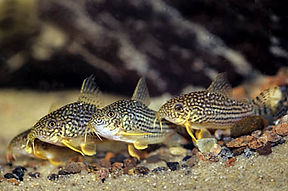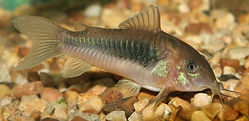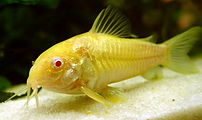Catfish Varieties :
Catfish can be found in every ecological niche. They are found all over the world, though primarily in fresh water, with the exception of Antarctica. There are some that live in the oceans, though the few catfish that do live in seawater are thought to spawn in brackish water. They are members of a huge order of fish called the the Siluriformes, or ray-finned fish, and there are over 2400 catfish varieties.
Catfish and humans have a very long history. People have fished and farmed them as a food source for hundreds of years in Africa, Asia, Europe, and North America. They are also popular in the aquarium hobby. They are enjoyed for their unique appearance but also as helpful scavengers to clean up left over foods.
Catfish are generally very hardy and easy to keep. Most are also nocturnal, becoming active at night, so they must be fed in the evening hours. Their eyes are small but they are aided in navigation and feeding by chemoreceptors all across their bodies which allow them to taste and smell anything that is in the water or that they touch. Their feeding habits range from plant-eaters and detritivores (those that scavenge on dead matter), to predators. Make sure they are eating since it's hard to tell with many of the armored catfish if they are losing weight.
Be careful when handling catfish since all species have strong, rigid spines on their dorsal and pectoral fins. These spines can pierce the skin and many species have "stings", though most stings are non-venomous.
The species list below includes popular catfish varieties as well lesser known species. Each fish guide has in-depth information including their places of origin, habitats and behaviors as well as the fish care needed for successfully keeping them in the aquarium. Catfish pictures are also provided within each fish guide to help with identification, and to aid in choosing pet fish.
1-Armored Catfish - Corydoras ( Click here to go to Corydoras Guide )
Family: Callichthyidae
Corydoras are ideal for every type of aquarist as they are very peaceful and very hardy!
These fish are very active during the day, always bobbing around and eating all manner of food from the bottom of the aquarium, keeping it clean with their scavenging! There are over 180 species of Corydoras known to icthyologists, about 50 are available to the hobby and about 10 are bred commercially. They are found in every river in South America, each with its' own distinct species and subspecies. Most of the fish in the Callichthyidae family require access to the air. They will often swim rapidly to the surface of the water for a gulp of air. This air is a supplement to their gills that is then utilized by being absorbed in their lower digestive tract. Coryadoras always swim in schools of dozens of fish, sometimes they even swim with other species.
2-Banjo Catfish
Family: Aspredinidae :
The "Banjo Catfishes" have the looks that only a mother could love (which makes them irresistable!)
As their name implies, these fish are shaped like a banjo. Banjo Catfish will often seem to be dormant as they don't move around very much. They are often a burrowing fish so a finer sand is appreciated.
The Banjo Catfish is a curious fish, with a curious name that describes its shape!
The Banjo Catfish Bunocephalus coracoideus is for the person looking for something unusual. It has a growing popularity in the aquarium industry mainly due to its very odd appearance.
This is a scaleless catfish. It has a laterally compressed body that is covered with horizontal rows of large horny projections, called unculiferous tubercles. The first part of its latin name, Bunocephalus, is derived from the greek word bounos means hillock which translates into "bumpy head."
Banjo Catfish are moderately hardy and can adjust to a variety of aquarium conditions. They can be kept as singly or as a group and are very peaceful fish, desirable in any community aquarium. They are compatible with all sizes of community fish, even the smallest of tank mates. All sorts of small fish ranging from tetras to cory catfish, and even dwarf cichlids, will do well when kept with this fish.
These are sedentary fish that seldom move around much. Banjo's are often mistaken for dead but when you try to take them out, they quickly swim away. They are also true scavengers, but because they are nocturnal, they feed at night. Their favored diet consists of different sorts of worms, but they will consume a wide variety of foods and debris on the substrate, even stuff that wasn't meant to be ingested! They are also burrowers so prefer a sandy bottomed tank with light vegetation.
-Kingdom: Animalia
-Phylum: Chordata
-Class: Actinopterygii
-Order: Siluriformes
-Family: Aspredinidae
-Genus: Bunocephalus
-Species: coracoideus
Habitat: Distribution / Background :
The Banjo Catfish Bunocephalus coracoideus was described by Cope in 1874. (Synonyms: Dysichthys coracoideus, Bunocephalus bicolor, Dysichthys bicolor, Bunocephalus haggini.). This species,Bunocephalus coracoideus can also be found in some publications as Dysichthys coracoideus, an original combination.
First thought to be a single species, the Banjo Catfish name incorporates several species all under the same common name. They originate from Peru, but their range goes throughout the Amazon into Bolivia, Uruguay, Brazil, and even as far west as Ecuador. Other common names they are known by include Guitarrita, Two Colored Banjo Catfish, Bicolor Banjo Catfish, Bicolour Banjo catfish, Bi-coloured Banjo, and Frying Pan Fish. Its close relative Bunocephalus amaurus, is also commonly called a Bi-coloured Banjo Catfish.
Bunocephalus coracoideus are primarily distributed in smaller streams, ponds, and lakes that all have calm conditions. Banjo Catfish love areas with lots of debris (e.g. wood) and leaf litter to hide under. They are omnivores and often consume organic debris. Because of their sedentary nature, they rarely "hunt" for any food. Banjo Catfish in the wild can be located alone or in small groups.
There are currently 10 species in the Bunocephalus genus. TheBunocephalus genus is the largest group in the South American family of catfishes called Aspredinidae. It is also the most widely distributed and the only genus found in rivers west of the Andes. The Aspredinidae family itself is comprised of three subfamilies with the Banjo Catfish being a member of the Bunocephalinae subfamily. The other two are Aspredininae and Hoplomyzontinae. Bunocephalinae have a can be distinguished from Aspredininae by their shorter body and anal fin
The Bunocephalus species have been described as being very similar to a genus called Dysichthys. These two genera were described as very similar in coloration and shape but with the Bunocephalus species having a much rougher grainier skin than the Dysichthys species. It is unclear whether Dysichthys is recognized today as its own distinct genus as it is currently included in some taxonomical resources and absent in others.
-
Scientific Name: Bunocephalus coracoideus
-
Social Grouping: Pairs - Singly or in small groups.
-
IUCN Red List: LC - Least Concern
Description:
The Banjo Catfish is a relatively small catfish, usually less than half a foot (15 cm). It is a scaleless fish with a wide head and a long slender body shape that resemble a banjo or guitar. Its body is laterally compressed and is covered with horizontal rows of large a wart-like projections, called unculiferous tubercles. This flattened slender body allows them to hide under many more objects than opposed to if they were bulkier. Their eyes are very small in comparison to their body, and its difficult to tell where their eyes and their mouths are. They have distinct pectoral fins and a long tail. But Banjo Catfish do not have an adipose fin and they lack the locking mechanism on their dorsal spine that is common in most species of catfish.
Due to its small size, it has numerous potential predators. To make up for this they have extremely advanced camouflage that literally makes them disappear into the debris of their natural habitat. Each individual has a unique mottling of browns and grays, and this along with the "bumps" all over their exterior contribute to their camouflage. Color patterns can range greatly.
-
Size of fish - inches: 5.9 inches (15.01 cm)
-
Lifespan: 12 years - These fish can live 8 to 12 years in the aquarium.


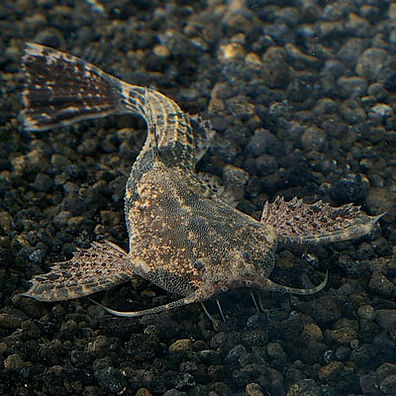
Fish Keeping Difficulty:
Despite their exotic appearance, Banjo Catfish are relatively easy to keep if they have the proper environment and are eating. As long as adequate hiding places are supplied without too much daily light, they are happy. Being nocturnal, they need to be fed in the evening. But because these fish are sedentary by nature, feeding won't be accomplished fast and it's important to make sure they are getting their needed share of food.
-
Aquarium Hardiness: Moderately hardy
-
Aquarist Experience Level: Intermediate
Foods and Feeding:
Banjo Catfish are omnivores. that feed on a wide variety of foods. These catfish are scavengers and are not too picky when it comes to mealtime. They prefer live foods such as bloodworms, earthworms, and tubifex. They also will accept frozen foods, flake foods, catfish pellets/tablets, and anything else that might sink to the bottom. It's important to note that these fish are generally nocturnal and shy individuals will not come out at feeding time if the lights are on. It's usually a good routine if you place their food in the tank right before you turn the lights out.
-
Diet Type: Omnivore
-
Flake Food: Occasionally
-
Tablet Pellet: Yes
-
Live foods (fishes, shrimps, worms): Some of Diet
-
Vegetable Food: Some of Diet
-
Meaty Food: Most of Diet
-
Feeding Frequency: Daily - Because they are nocturnal, they need to be fed in the evening after lights are out.
Aquarium Care :
Banjo Catfish require no special aquarium maintenance. Simply make sure to siphon the substrate to ensure it is clean and free of dangerous ammonia pockets. They do well in most reasonable aquarium environments. The recommended water change is 10 - 15% every other week to keep up with the bio-load.
-
Water Changes: Bi-weekly - Do water changes of 10 - 15% every other week.
Aquarium Setup :
A minimum 25 gallon aquarium is recommended for the Banjo Catfish. These catfish require ample hiding places, particularly driftwood which mimics their natural environment. Have a few open spaces around their hideaways to drop their food in. After a while, they should come out and eat in daylight. Sand is recommended to allow the fish to bury under. Water parameters don't have to be specific, and they can range quite drastically without affecting them. One great thing about this catfish is its ability to thrive in pH extremes.
-
Minimum Tank Size: 25 gal (95 L)
-
Suitable for Nano Tank: Sometimes - If it is a larger sized Nano tank, at least 25 gallons
-
Substrate Type: Sand - Fine sand or sand gravel mix should be provided so the fish can burrow.
-
Lighting Needs: Low - subdued lighting
-
Temperature: 68.0 to 84.0° F (20.0 to 28.9° C)
-
Range ph: 5.0-8.0
-
Hardness Range: 5 - 19 dGH
-
Brackish: No
-
Water Movement: Moderate
-
Water Region: Bottom
Social Behaviors :
Banjo Catfish are the epitome of a peaceful nature. They get along excellently in a community tank, though they are reclusive and nocturnal so may be rarely seen. Banjo Catfish are fine alone or in groups of their own kind, and can coexist with the smallest and most docile of fish. But be careful when adding them to a tank with boisterous and aggressive fish. This could end badly for the Banjo because they have few defenses and rely on camouflage, which is hard to achieve in an aquarium.
-
Venomous: No
-
Temperament: Peaceful - Peaceful and remarkably inactive. It appreciates hiding places and sand to burrow in.
-
Compatible with:
-
Same species - conspecifics: Yes
-
Peaceful fish (): Safe
-
Semi-Aggressive (): Monitor
-
Aggressive (): Threat
-
Large Semi-Aggressive (): Monitor
-
Large Aggressive, Predatory (): Threat
-
Slow Swimmers & Eaters (): Safe - The Banjo Catfish is a slow swimmer and eater.
-
Shrimps, Crabs, Snails: Threat - is aggressive - Banjo catfish have been known to eat snails and other invertebrates.
-
Plants: Monitor - May tear up plants to provide spawning areas under the leaves.
-
Sex: Sexual differences :
Though both sexes look similar, a mature female Banjo Catfish can be recognized by her fuller and rounder belly.
Breeding / Reproduction :
Banjo Catfish reach sexual maturity at about 4 1/2 inches. In the wild, it is possible that the Banjo Catfish spawn in groups. In an aquarium, the breeding pair prefer to spawn in a natural rock cave with a sandy bottom. However if rocks shelters are not available, they may tear up plants in order to drop leaves under which they may spawn.
Spawning usually happens in the dark, particularly at night where numerous batches of eggs are randomly deposited in an egg-scattering fashion. This often occurs over several nights, adding up to 4000-5000 eggs in total. Interestingly, this species incubates their eggs like a chicken by sitting on them. However, to protect the fry from other fishes they should be removed from the main aquarium (or placed in a hanging fry net). The eggs hatch in approximately three days. The newly hatched fry should be fed miniscule live foods. They can be fed rotifers and later tubifex worms. The fry won't eat flake foods or Daphnia. This can be exchanged for tubifex worms and tablet food as they get older.
-
Ease of Breeding: Difficult - Aquarium breedings are very rare. Spawning occurs in a group and the eggs should be removed.
Fish Diseases :
Banjo Catfish are not particularly susceptible to any one disease. If proper conditions and acclimating methods are met they should live healthy, long lives. Like most catfish, they are sensitive to ammonia poisoning because they occupy the bottom of the tank where ammonia is more concentrated. That's why regular siphoning is crucial.
Because they are a scaleless fish, catfish can be treated with pimafix or melafix but should not be treated with potassium permanganate or copper based medications. Malachite green or formalin can be used at one half to one fourth the recommended dosage. All medications should be used with caution.
The best way to proactively prevent disease is to give your fish the proper environment and give them a well balanced diet. The closer to their natural habitat the less stress the fish will have, making them healthier and happy. A stressed fish will is more likely to acquire disease. For information about fish diseases and illnesses..
Availability:
Banjo Catfish are becoming increasingly popular and are usually easy to find in most fish specialty stores and online. Occasionally, you will find them in a general pet store. Prices are reasonable.
References
-
Animal-World References: Freshwater Fish and Plants
-
Glen S. Axelrod, Brian M. Scott, Neal Pronek, Encyclopedia Of Exotic Tropical Fishes For Freshwater Aquariums, TFH Publications, 2005
-
Dr. Herbert R. Axelrod, Aquarium Fishes of the World, TFH Publications, 1998
-
Dr. Rüdiger Riehl and Hans A. Baensch, Aquarium Atlas Vol. 1, Publisher Hans A. Baensch, 1991
-
Bunocephalus coracoideus, The IUCN Red List of Threatened Species
3-Flat-nosed Catfish - Antenna Catfish
Family: Pimelodidae :
The attractive catfishes in the family Pimelodidae have been prized by collectors because of the great diversity in both size and patterning!
he Flat-nosed Catfish, or Antenna Catfish have extremely long adipose fins, some as long as a third of their length, and their "whiskers" or barbels are also unusually long. Though they are mostly peaceful, these catfish have large mouths and can swallow a good sized fish. Be careful that the tankmates you choose are not much smaller than your catfish!
- Four-Lined Pimelodus
Four-lined Pimodella, Dusky Pimelodid, Bloch’s Catfish
The Four-lined PimelodusPimelodus blochii is a very handsome and hardy fish. When young its color is a pretty silver gray striped over with a darker gray which aptly gives them their name. While the term Pimelodus literally translates into “fat tooth”, the first part of its common name comes from the four lateral stripes on the flanks. Though this is there appearance when young, they often loose the striping as adults and becoming a more dusky gray. Other common names it is known by include Four-lined Pimodella, Dusky Pimelodid, and Bloch’s Catfish.
The Bloch’s Catfish has a flat-fronted nose and long flowing barbels. These characteristics lend themselves to the more generalized common names of Antenna Catfish and Flat-nosed Catfish. Like the other long-whiskered catfishes of the Pimelodidae Family, it locates its food by smell and by probing with its antennae. The Four-lined Pimelodus especially likes worms of all kinds and some of its favorites are bloodworms and earthworms.
The dorsal fin of the Four-lined Pimelodus has a strong, rigid spine with saw-edged tips that act like barbed hooks. It used to be thought that the spine was poison, as it is on a number of catfishes. But more recently several authors have said this is probably not true.
The Four-lined Pimelodus is moderately hardy, but needs an aquarium of at least 55 gallons or more. They swim in the lower portion or bottom of the aquarium and should be provided places to hide during the day. They are nighttime feeders but are not fussy about their food. They will eat most anything though have a preference for meaty foods, especially worms. In oxygen depleted waters, the Four-lined Pimelodus can change almost entirely to surface breathing. In the aquarium it will occasionally go to the surface to breath air through its intestinal respiratory system. These fish can also be kept in brackish water.
Four-lined Pimodella catfish are generally peaceful and can be kept in a community aquarium. However they are hearty feeders and will snack on any fish small enough to fit in their mouths. Larger active tetras, most barbs, gouramis, rasboras and other similar fish will be fine. Graceful fish types, like angelfish, may be bothered by the prodding of their barbels, especially after dark when these catfish are searching for food. They can be kept singly or in a group of their own kind, as well as with other catfish species like Plecostomus, Loricaria, Corydoras, Acanthodoras, and even larger cichlids.
The Four-lined Pimodella is often confused with its relative the Pictus Pimodella or Pictus Cat Pimelodus pictus. However the Four-lined Pimelodus doesn't have the spotted patterning of the Pictus catfish. Also it is a much larger catfish, reaching about 8 inches (20 cm) in the aquarium while the Pictus Pimelodus only reaches only about 4 1/2 inches (11 cm) in the aquarium.
-Kingdom: Animalia
-Phylum: Chordata
-Class: Actinopterygii
-Order: Siluriformes
-Family: Pimelodidae
-Genus: Pimelodus
-Species: blochii
Habitat: Distribution / Background :
The Four-lined Pimelodus Pimelodus blochii was first described by Valenciennes in 1840. They inhabit much of South and Central America, from Panama to Brazil. They are found in the Amazon and Orinoco river systems, as well as the Gulf of Paria and throughout much of Guyana. The first part of their common name comes from the fact they have four lateral stripes on their flanks, while the latin term Pimelodus means “fat tooth”. Other common names they are known by include Four-lined Pimodella, Dusky Pimelodid, Bloch’s Catfish, Antenna Catfish, and Flat-nosed Catfish.
The adaptable nature of the Dusky Pimelodid allows them to exist in brackish and freshwater conditions. They prefer moderately fast flowing river systems and are found near the bottom where they locate and hunt for food. They feed on insects and very small fish, but will also scavenge for fruit and ‘leftovers’. Four-Lined Pimelodus are gregarious and enjoy the company of their own kind.
Pimodella catfish is a common phrase used to describe a number of species that are members of either the Pimelodella genus or the Pimelodus genus. At one time these two genera were both classed as members of the Pimelodidae Family. However the taxonomy of the Pimelodidae family has been going through much revision. The Pimelodella genus has been moved into the Heptapteridae family while the Pimelodus genus remains in the Pimelodidae Family. Within the clade revision these two families are members of a Superfamily called Pimelodoidea.
- Scientific Name: Pimelodus blochii
- Social Grouping: Groups - Four-Lined Pimelodus are gregarious.
- IUCN Red List: NE - Not Evaluated or not listed
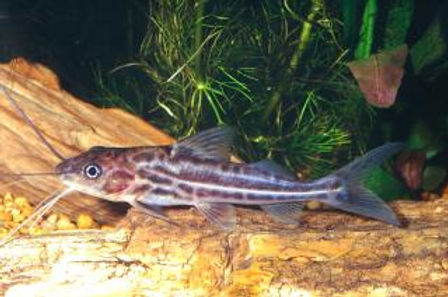
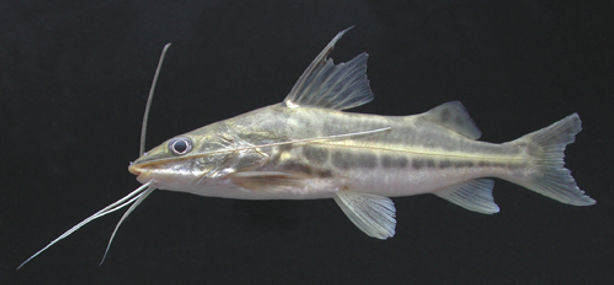
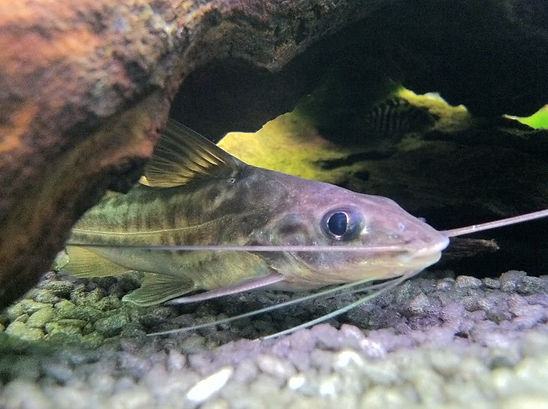
Description :
The Four-lined Pimelodus is a moderately large sized catfish, reaching up to about 14 inches (35 cm) in the wild. In the aquarium it will generally reach about 8” (20 cm). Its base color is silver gray, which is striped over with a darker gray that gives them their apt name. As they mature, they often lose this striping and turn into a washed out gray tone. As with most catfish, they have flattened undersides and triangular flanks, leading up to their sharp, pointed dorsal fin. Their antennae are extremely long, allowing them to navigate in murky conditions and find the coordinates to nearby food. There are many color variances of this species which makes them hard to identify, but whether any subspecies exist are unknown at this point.
-
Lifespan: 8 years - They generally live 8 to10 years, but have been reported to live up to 15 years in the aquarium.
-
Size of fish - inches: 14.0 inches (35.56 cm) - They usually only obtain about 8” (20 cm) in the aquarium.
Fish Keeping Difficulty :
These catfish are not hard to keep if proper conditions are met. They require aquariums 55+ gallons and can be messy, so frequent cleanings are required. They are unfussy about water parameters and will eat nearly anything. They become hardy if these conditions are met when they are first transferred to a new aquarium.
-
Aquarium Hardiness: Moderately hardy
-
Aquarist Experience Level: Intermediate
Foods and Feeding :
Four-lined Pimelodus are omnivores that are far from fussy. They will happily consume most fish foods, but they do prefer meaty foods, especially worms. Their scavenger instincts will make them easy to feed. They’ll eat all kinds of live, fresh, and flake foods as well as pellets, tablets, and any foods that reach the bottom region of the tank.
To keep a good balance give them a high quality flake food or pellet everyday. It there is a lot of foods available, they will often gorge themselves until a prominent belly is showing. Don’t be alarmed, it is normal for them to do this and they can live off that type of feeding for up to a week. They will very happily take the treat of bloodworms or earthworms.
-
Diet Type: Omnivore
-
Flake Food: Yes
-
Tablet Pellet: Yes
-
Live foods (fishes, shrimps, worms): Some of Diet
-
Vegetable Food: Some of Diet
-
Meaty Food: Most of Diet
-
Feeding Frequency: Daily - Offer a high quality flake food or pellet everyday, however if they are given the opportunity to gorge themselves on available foods, they will, and then they may go for up to a week without additional feedings.
Aquarium Care:
The Four-lined Pimodella requires no special aquarium maintenance. They like opaque, blackwater such as is found in slow moving parts of the Amazon, but they do well in most reasonable aquarium environments. The recommended water change is 10 - 15% every week or 25% bi-weekly to keep up with the bio-load.
-
Water Changes: Weekly - Water change of 10 - 15% every week, 25% or more bi-weekly to keep up with the bio-load.
Aquarium Setup :
A minimum 55 gallon aquarium is recommended for the Dusky Pimelodid. Pimelodus blochii prefer spacious aquariums with ample swimming space. Yet they also need numerous hiding places, like slate or driftwood, to make these generally nocturnal fish feel secure. Smooth gravel or sand is the best type of substrate for these catfish so they do not damage their antennae. Water parameters don’t have to be specific, they can range quite drastically without affecting them. This is partially due to their ability to adapt between freshwater and brackish water habitats.
-
Minimum Tank Size: 55 gal (208 L)
-
Suitable for Nano Tank: No
-
Substrate Type: Sand/Gravel Mix - Preferably a sand or fine gravel substrate.
-
Lighting Needs: Low - subdued lighting - Moderate lighting is okay if there is floating plant cover or numerous dark hiding spots.
-
Temperature: 68.0 to 79.0° F (20.0 to 26.1° C)
-
Range ph: 6.0-7.5
-
Hardness Range: 4 - 10 dGH
-
Brackish: Sometimes - These fish move between brackish waters and freshwater in nature.. They can tolerate brackish water but it is unclear if this is good for a long term.
-
Water Movement: Moderate
-
Water Region: Bottom - Sometimes in the lower reaches of middle area of the aquarium as well.
Social Behaviors :
Four-Lined Pimelodus are usually peaceful, gregarious fish, existing well in peaceful to semi-aggressive communities. They will, however, consume small fish like Neon Tetras and will sometimes nip at slow, longer finned fish if they become bored. Graceful fish types, like angelfish, may be bothered by the prodding of their barbels, especially after dark when they search for food. Larger active tetras, most barbs, gouramis, rasboras and other similar fish will be fine.
They can be kept singly or in a group of their own kind, as well as with other catfish species like Plecostomus, Loricaria, Corydoras, Acanthodoras, and even larger cichlids. Keeping them in group helps to keep them preoccupied with each other and avoid harassing other fish.
-
Venomous: Unknown - There is conflicting literature on the subject of the possibility of this fish having venom in its spines.
-
Temperament: Semi-aggressive - Some fish will be bullies although overall they are agreeable fish.
-
Compatible with:
-
Same species - conspecifics: Yes - They will nip at the fins of the same species, but generally cause little harm.
-
Peaceful fish (): Safe - Don't keep with fish that are much smaller since these catfish are predaceous.
-
Semi-Aggressive (): Safe
-
Aggressive (): Monitor
-
Large Semi-Aggressive (): Safe
-
Large Aggressive, Predatory (): Threat
-
Slow Swimmers & Eaters (): Monitor
-
Shrimps, Crabs, Snails: May be aggressive - May consume small snails and shrimp.
-
Plants: Safe
-
Sex: Sexual differences:
There is no known way to sexually differentiate these fish – males may grow larger.
Breeding / Reproduction :
The Four-Lined Pimelodus have not been successfully bred in aquariums. In the wild the Pimelodus blochii are seasonal breeders. Spawning occurs only once a year during the rainy season, and only for a short period of time.. They are thought to migrate upstream during reproduction. The female lays an average of 50,000 eggs which are fertilized externally.
-
Ease of Breeding: Unknown - This fish has yet to bred in home aquaria.
Fish Diseases :
Four-Lined Pimelodus have no specific diseases associated with them. If proper conditions and acclimating methods are met they tend to be hardy fish. Like most catfish,being scaleless it makes them difficult to treat, particularly if they get Ich. For information about freshwater fish diseases and illnesses, see Aquarium Fish Diseases and Treatments.
Because they are a scaleless fish, catfish can be treated with pimafix or melafix but should not be treated with potassium permanganate or copper based medications. Malachite green or formalin can be used at one half to one fourth the recommended dosage. All medications should be used with caution.
Availability :
Four-Lined Pimelodus are not hard to obtain, but are only occasionally found in pet stores. Special orders or online orders might be required. They are moderately priced.
References
-
Animal-World References: Freshwater Fish and Plants
-
Dr. Rüdiger Riehl and Hans A. Baensch, Aquarium Atlas Vol. 1, Publisher Hans A. Baensch, 1991
-
Dr. Herbert R. Axelrod, Dr. Warren E Burgess, Dr. Cliff W. Emmens, Neal Pronek, Jerry G. Walls, Ray Hunziker,Dr. Axelrod's Mini-Atlas of Aquarium Fishes, Mini- Edition, T.F.H. Publications, Inc., 1987
-
Pimelodus blochii Valenciennes, 1840 Bloch's catfish, Fishbase.org
-
Pimelodus blochii, PlanetCatfish
- Red-tailed Catfish:
Redtail Catfish, South American Red Tailed Catfish
Big and beautiful, the Red-tailed Catfish is an enormous attraction!
The Red-tailed CatfishPhractocephalus hemioliopterus is easily recognized and one of the most attractive of the catfish species. As a member of the Pimelodidae family it is long whiskered, but Its beautiful red tail and white belly are its unmistakable characteristics. This fish is the only member of its genus and with its distinct appearance, it's only confused with an occasional hybrid that may appear from time to time. It is also known as the South American Red Tailed Catfish, Banana Catfish and Redtail Catfish. Flat-nosed Catfish and Antenna Catfish are generic names applied to this fish as well as some other members of its family.
This catfish gets really big. They can reach 3 feet or more in captivity and there are reports of specimens reaching up to 5 feet in the wild. Because of their large size they are a favorite game fish and anglers love them. The International Game Fish Association (IGFA) reports that the current world record weight for this fish is a whopping 123 lbs. 7 oz. (56 kg). This world record is held by Gilberto Fernandes for a specimen he caught in the Amazon River on April 3, 2010.
Even though the Red-tailed catfish is one of the larger fish in the Amazon, this is not a food fish for the natives. It has a dark colored flesh and according to Dr. Herbert R. Axelrod, in his book 'Aquarium Fishes of the World (1998)', the natives will only eat white flesh. According to Wikipedia, in an attempt to develop a viable food fish they have been hybridized with other fish species, like the Pseudoplatystoma sp. of Tiger Shovelnose. The resultant hybrids are generally known as Tiger Redtail Catfish. These will sometimes show up in the aquarium hobby under various common names.
Despite their attractive appearance, these catfish get very large and so are not recommended for the average aquarist. They are only able to be kept in a smaller aquarium as juveniles. Being fast growers they will quickly need a larger and larger aquarium. A minimum sized tank would be at least 1000 gallons, and for the largest sized ones it could easily be 1500 gallons or more. This is a huge tank, making them not really suitable for most homes. They are best left to public aquariums or only kept by advanced aquarists with the space and means to provide them with the appropriate habitat and care for their entire lifespan.
Red-tailed Catfish are not real active and would prefer a large cave or den to hang out in. If the tank is dimly lit, then just a few large pieces of bogwood will suffice. These fish are actually quite peaceful, but they have a big mouth and a hearty appetite. They can't be kept with smaller fish as these tank-mates will become lunch sooner or later. They are also territorial with their own kind as well as other catfish from the Pimelodidae family, but are fine kept with other same-sized large fish with a similar temperament.
-
Kingdom: Animalia
-
Phylum: Chordata
-
Class: Actinopterygii
-
Order: Siluriformes
-
Family: Pimelodidae
-
Genus: Phractocephalus
-
Species: hemioliopterus
Habitat: Distribution / Background :
The Red-tailed Catfish Phractocephalus hemioliopterus was described by Bloch and Schneider in 1801. This fish is from a genus that is over 13.5 million years. It is said to be the last living fishin its genus, yet there are reports of a possible undescribed member existing from Acre, Brazil.
These catfish are found throughout much of the Amazon, Orinoco, and Essequibo river basins of South America. They occur in Colombia, Venezuela, Guyana, Ecuador, Peru, Bolivia and Brazil. They have also been record in the United States as nonindigenous species in Florida, Nebraska, Missouri, Tennessee and multiple reports by anglers in Texas. They were probably released by irresponsible pet owners.
They are not listed on the UCN Red List of Endangered species. Other common names they are known by are South American Red Tailed Catfish, Banana Catfish and Redtail Catfish, along with Flat-nosed Catfish and Antenna Catfish that are generic names applied to some members of the Pimelodidae family.
These catfish are only found in freshwater and occur in a broad range of habitats. They can be found in rapids to areas of flooded forest but prefer deep pools in rivers. In nature they will normally consume other fish, crabs, crustaceans, fruits, and seeds that fall into the waters. These fish are known to be very slow moving bottom fish that will ambush their prey with their slow swimming habits. They use a very well developed chemosensory and stealth ability to capture their prey. They are a solitary fish, territorial with their own kind as well as other catfish from the Pimelodidae family,
-
Scientific Name: Phractocephalus hemioliopterus
-
Social Grouping: Solitary
-
IUCN Red List: NE - Not Evaluated or not listed
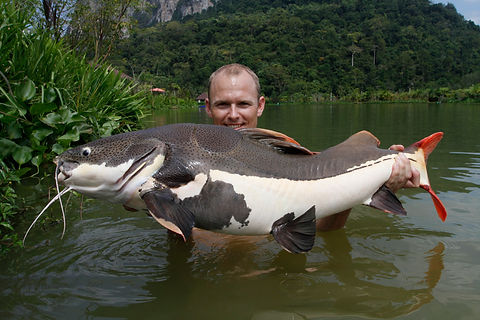
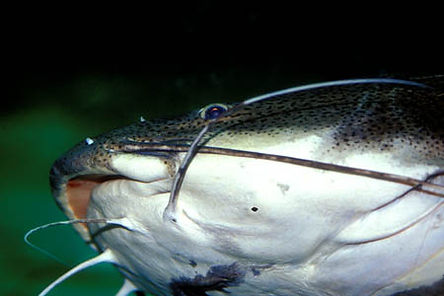
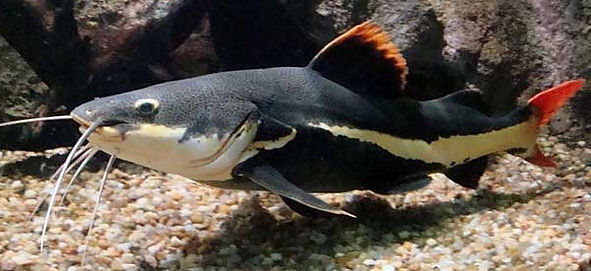
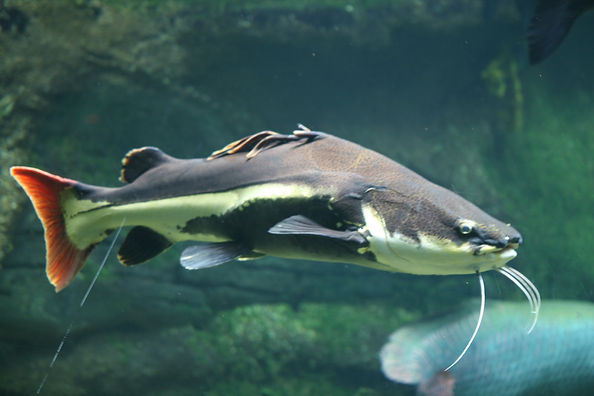
Description :
The Red-tailed Catfish is a large fish. It has a rather cylindrical, arrow-shaped body with a flattened belly and a laterally compressed tail. Their shovel-like mouth is moderately depressed and is as wide as the body, with "whiskers" or barbels that are unusually long. The eyes are set on either side of the head near the top.
The color is dark gray on the top of the body, covered with small darker spots. The lower part of the mouth is white, The white then extends in a broad horizontal stripe back to the tailfin. As a juvenile this white stripe joins with the white under the mouth, but as it gets older it is broken up just before the mouth with dark gray coloration. The tip of the dorsal fin and the tail fin are slightly pinkish red.
They will generally reach up to about 4.4 feet (1.35 m) in length in captivity, though in the wild they are documented to reach up to 5 feet 11 inches (1.8 m) and weigh as much as 180 pounds (80 kg). They have an average lifespan of up to about 20 years.
-
Size of fish - inches: 53.0 inches (134.62 cm) - They will generally reach up to about 4.4 feet (1.35 m) in length in captivity, but there are reports of fish reaching sizes upwards of 5 feet in the wild, and the largest documented size was 53 inches.
-
Lifespan: 20 years
Fish Keeping Difficulty
Although these fish are quite hardy, they get extremely large and so are not recommended for the average aquarist. They should not be kept in a home aquarium unless the fish keeper has a huge tank of at least 1000 gallons (1500 gallons or more for the larger specimens) and the money to maintain such a large fish. They should only be kept by advanced aquarists that can meet the tank requirements and financial responsibility for the entire lifespan of the fish (20 years or so). They are best left to public aquariums.
These fish are very popular as small young fish, but because they grow so fast and get so large, many aquarist try to donated them to local aquariums. But these public facilities are now are so overpopulated that they have to turn most donations away.
-
Aquarium Hardiness: Difficult to Impossible - Though a very hardy fish, they are difficult to Impossible for most aquarists to keep. They require a massive tank and a diet of live fish. It is generally agreed upon that this fish is not really suited for the home aquarium.
-
Aquarist Experience Level: Advanced - This fish is too large for all but the most extremely oversized of tanks.
Foods and Feeding :
Red-tailed Catfish are omnivorous but prefer meaty foods. As juveniles, they will generally eat all kinds of live, fresh, and flake foods. To keep a good balance give them a high quality flake food or pellet everyday. As they grow go offer higher percentages of pellets, live or frozen foods, and fruits. Be cautious as these fish will and can eat anything that fits in their mouth, including filter parts and heaters.
They should not be fed the meat of mammals, including beef heart and chicken. These types of meats contain lipids that these fish cannot metabolize properly. This can can cause problems such as excess deposits of fat and even organ degeneration. Also be cautious with feeder fish like goldfish or livebearers, such as guppies, as they can introduce disease unless properly quarantined and medicated as needed prior to feeding.
Once these fish mature it is very important to vary their eating schedule as overfeeding can kill them. These fish will only require one large meal per week and then the rest of the week will be used to digest the food. When these big fish eat they get very sluggish, and then will not get really active until they are ready to eat again. So their feeding times will vary depending on their digestion.
-
Diet Type: Omnivore
-
Flake Food: No - Only as a small juvenile will they consume flakes.
-
Tablet Pellet: Yes - This fish will ocassionally accept processed foods but prefers a diet of live prey or meaty foods.
-
Live foods (fishes, shrimps, worms): Some of Diet
-
Vegetable Food: Some of Diet
-
Meaty Food: Most of Diet
-
Feeding Frequency: Weekly - Juveniles should be fed about every other day, but as the fish ages this should be reduced to a weekly feeding. Reduced activity levels and its preference for a high protein diet will otherwise lead to excessive weight gain.
Aquarium Care :
These are hardy fish, but do best with a large sump filter system to keep the water clean and circulating. If needed, they will swim to the top and gulp air and then swim back down to the bottom. This behavior is a good indicator that the water quality is deteriorating, so if it is a common occurrence than it's time to check your water parameters. Weekly water changes of 30% a week are necessary, and important to keep this fish happy.
-
Water Changes: Weekly - These fish require water changes of 30% a week.
Aquarium Setup:
Red-tailed Catfish are monster sized fish, though not overly active. The absolute minimum size for an adult is 1000 gallons with a large sump filter system. For larger specimens 1500 gallons or more will be needed. Juvenile specimens grow very fast and will quickly need a large tank. Upgrading to a larger tank will be necessary as they grow, and this is a stressful thing for the fish. You can transfer the old tanks water to the new tank to help make sure the water parameters are the same. The upgraded filter can also have material transferred from the old filter to help with cycling the tank. Its best if the nitrification cycle is complete before transferring this fish.
The decor is not very important for this large fish as they will most likely destroy or rearrange the entire tank. Large branches and big rocks are usually good if you want to add some decorations. To be comfortable, the tank lighting should be subdued unless you have a cave or den for the fish to hide and be comfortable. It is best to use external filters and heaters; these monsters have been known to eat them and this can cause death to the fish.
-
Minimum Tank Size: 1,000 gal (3,785 L) - 1000 gallons is the absolute minimum for an average sized fish, 1500 gallons or more will be needed for larger specimens. Juvenile specimens will quickly outgrow a small tank, and if kept in overly cramped quarters this species will not survive.
-
Suitable for Nano Tank: No
-
Substrate Type: Any
-
Lighting Needs: Moderate - normal lighting - They prefer a dim tank if there is little decor, but will do fine with normal lighting if provided a cave type enclosured space to hide in.
-
Temperature: 68.0 to 79.0° F (20.0 to 26.1° C)
-
Range ph: 5.5-7.2
-
Hardness Range: 3 - 12 dGH
-
Brackish: No
-
Water Movement: Moderate
-
Water Region: Bottom - These fish will swim in the bottom of the aquarium. As they get older, they may stay motionless for long periods of time.
Social Behaviors:
The Red-tailed Catfish are generally a good community fish with tank-mates their own size. However they are territorial with their own kind as well as other catfish from the Pimelodidae family. In public aquariums they are put in large groups and remain peaceful, but they are in enormous tanks. Don't keep them with fish that are much smaller since theses catfish are predaceous, and the smaller tankmates will be eaten.
-
Venomous: No
-
Temperament: Large Aggressive - Predatory - Peaceful although somewhat territorial. Red-tailed Catfish are highly predatory.
-
Compatible with:
-
Same species - conspecifics: No - They are territorial with their own kind as well as other members of the Pimelodidae family.
-
Peaceful fish (): Monitor - They are fine with same-sized fish, but will eat anything smaller.
-
Semi-Aggressive (): Threat
-
Aggressive (): Threat
-
Large Semi-Aggressive (): Safe
-
Large Aggressive, Predatory (): Safe
-
Slow Swimmers & Eaters (): Monitor - Peaceful with same-sized fish, but smaller fish will be eaten.
-
Shrimps, Crabs, Snails: Threat - is aggressive - They feed on crabs and other crustaceans in the wild.
-
Plants: Safe
-
Sex: Sexual differences :
Not known.
Breeding / Reproduction:
There are no reports of the Red-tailed Catfish having been successfully bred in aquariums. Breeding has been accomplished in South American fisheries however, via the use of hormones. These fish are used primarily as a food source but some make it into the aquarium trade. For general information on the breeding of catfish in the aquarium, see: Breeding Freshwater Fish: Catfish.
-
Ease of Breeding: Unknown - This fish is too large to be bred in a home aquarium.
Fish Diseases :
The Red-Tailed Catfish are very hardy but are subject to the same diseases as other tropical fish. Disease is not usually a problem in a well maintained aquarium and these catfish are very resilient. High nitrate levels can cause catfish to develop infected barbels; which makes it difficult for them to navigate and eat normally. Maintain nitrate levels below 20 ppm through regular water changes.
All medications should be used with caution. Because they are a scaleless fish, catfish can be treated with pimafix or melafix but should not be treated with potassium permanganate or copper based medications. Malachite green or formalin can be used at one half to one fourth the recommended dosage. Take care when treating disease as catfish are extremely sensitive to medications.
Availability
The Red-tailed Catfish is available from time to time and is moderately expensive.
References:
-
Animal-World References: Freshwater Fish and Plants
-
Phractocephalus hemioliopterus (Bloch & Schneider, 1801) Redtail catfish, Fishbase
-
Joseph S. Nelson, Fishes of the World, Wiley, 2006
-
Lee Finley, Catfishes: The Complete Guide to the Successful Care and Breeding of More Than 100 Catfish Species, T.F.H Publications, Inc. 2003
-
Dr. Herbert R. Axelrod, Aquarium Fishes of the World, TFH Publications, 1998
-
Richard Geis, Catfish Keeping & Breeding Them in Captivity, T.F.H Publications, Inc. 1996
-
Dr. Rüdiger Riehl and Hans A. Baensch, Aquarium Atlas Vol. 1, Publisher Hans A. Baensch, 1991
-
catfish, redtail (pirarara),(Phractocephalus hemioliopterus), International Game Fish Association (IGFA)
-
Phractocephalus hemioliopterus Red-tail Catfish, SeriouslyFish.com
-
Redtail catfish, Wikipedia
4- Pangasius Catfish - Iridescent Shark Catfish
Family: Pangasiidae
Iridescent Shark Catfish are very graceful, elegant swimmers and beautiful fish to watch!
The Iridescent Shark Pangasianodon hypophthalmus (previously Pangasius hypophthalmus) is a very active catfish. They are schooling fish, and a group of these swimmers makes a delightful display. The name is derived from its juvenile coloring, a silvery iridescence with a couple dark stripes, and a body shape resembling that of a shark. As they reach their adult size, which can be up to a whooping 4 feet (130 cm) in length in the wild, their coloring becomes a uniform darker gray, often without the striping.
The Iridescent Shark Catfish has a very long history with humans. Southeast Asian nations have been utilizing it as an important food fish for hundreds of years and it is also a popular aquarium fish. It is known by a number of common names. The names Pangasius Catfish and Sutchi Catfish are derived from scientific names it had previously been described by, most recently Pangasius hypophthalmus and early as Pangasius sutchi.Tiger Shark, Shark Catfish, and Striped Catfish relate to its appearance, while Siamese Shark and Asian Shark Catfish relate to its place of origin as well as its appearance. Striped Catfish is also its common name in the food fish market.
The Pangasius Catfish are so attractive as juveniles that aquarists find then very desirable. Unfortunately this is a catfish for a very large aquarium only. They are relatively hardy and are peaceful with other fish, as long as their tank mates are too big to swallow. But due to their size they are not the best aquatic fish to keep in a home aquarium. Juveniles can be started in a 100 gallon aquarium, but once they reach their adult size, generally about about 39 inches (100 cm) in the captivity, they will require an aquarium the size of at least 300 gallons or more. They are also very active fish that need a lot of room to swim, and they don't thrive as well if kept singly as juveniles. Iridescent Sharks really need to be kept in small groups of about 5 or so fish to do well.
The Iridescent Shark is known as a Naked Catfish and like all catfish species it is scaleless, but unlike others its skin is not covered by bony plates or other armor. Consequently it can be easily scratched and damaged. It also does not possess the bottom dwelling habit we usually identify with most catfishes, but rather occupies the middle of the aquarium. They are constantly on the move and will occasionally go to the surface for air. These fish are also diurnal, meaning they are active during the day and enjoy a well lighted aquarium.
Be cautious! The Pangasius Catfish have bad eyesight and they are a nervous fish that can be easily spooked. Don't tap on the glass or startle the fish as it is likely to injure itself in its mindless flight. They can get hysterical when frightened and dash madly around the aquarium. They will often bash into the sides of the aquarium, ornaments or other fish. After such a flight, you may see the fish sink to the bottom of the aquarium and lie on its side or back until it recovers.
-
Kingdom: Animalia
-
Phylum: Chordata
-
Class: Actinopterygii
-
Order: Siluriformes
-
Family: Pangasiidae
-
Genus: Pangasianodon
-
Species: hypophthalmus
Habitat: Distribution / Background :
The Iridescent Shark Pangasianodon hypophthalmus was described by Sauvage in 1878. However due to the fact that Southeast Asian nations have been catching this fish as a food source for hundreds of years, no one is sure who discovered it. This species has recentlybeen moved from the Pangasius genus to the Pangasianodon genus. Pangasius hypophthalmus is now a synonym rather than a valid species name, as is the even early described name Pangasius sutchi.
The Iridescent Shark is native to the Mekong basin, as well as the Chao Phraya River and Maeklong basin, chiefly in Thailand, Myanmar, Laos, and Vietnam. They have also been Introduced into other river basins for aquacultural purposes. They are found as juveniles in schools of large numbers, especially in stretches of rapids in major Asian rivers, but are loners as adults. In the wild they feed on fish, shrimp and various crustaceans, insect larvae, fruit, and vegetable matter.
They are commonly available in the aquarium trade and are a food stable in Southeast Asian countries such as Thailand, or Laos, where it is used as an important food source. In Thailand, it is considered the most important aquaculture fish. Other common names they are known by are Pangasius Catfish, Sutchi Catfish, Siamese Shark, Asian Shark Catfish, Shark Catfish, Tiger Shark, and Striped Catfish.
There are several variations of this fish. Most notably are the Albino Iridescent Shark or Albino Pangasias Catfish which is commonly available, and also ‘short body/balloon’ forms. The latter form remains smaller than the natural fish. The Iridescent Shark Catfish is on the IUCN Red List for Least Concerned with a stable population.
-
Scientific Name: Pangasianodon hypophthalmus
-
Social Grouping: Groups - They are found in large schools as juveniles, but but are loners as adults.
-
IUCN Red List: LC - Least Concern
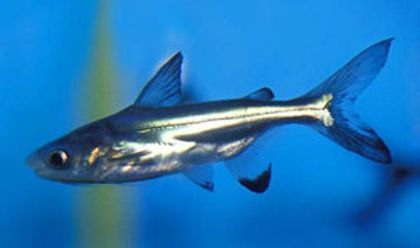

Description :
The Iridescent Shark a large sized catfish with a body shape resembling that of a marine shark. It has a laterally compressed body, and like other catfish it has two pairs of barbels. It has a short dorsal fin on top with one or two spines and also has strong spines on each of the pectoral fins. It has a well developed adipose fin on the underside and a long anal fin (tail fin).
This catfish typically has a glow or iridescence exhibited in juveniles, along with two dark broad vertical bands. One is along the lateral line and the other is just below it, extending from above the pectoral fin base towards the forepart of the anal fin. Adults are generally darker colored and often lack the striping, yet they still retain the glimmering glow that gives them their name. The fins are dark gray or black.
This is a large fish that can reach a maximum size of 4 feet (130 cm) in length and have been known to weigh 97 lbs. (44.0 kg). They will generally reach about 39 inches (100 cm) in the aquarium, and have a lifespan of up to 20 years. There are also other species of Pangasius that are sometimes sold as Pangasius Catfish, namely Pangasius pangasius and Pangasius gigas, that can reach 9 feet (300 cm) long!
-
Size of fish - inches: 51.2 inches (130.00 cm) - They usually only obtain about 39 inches (100 cm) in the aquarium.
-
Lifespan: 20 years
Fish Keeping Difficulty :
While Pangasius Catfish are considerably hardy, they are not the best aquatic fish to keep in a home aquarium. This is due to the fact that once they reach their adult size they will require an aquarium the size of at least 300 gallons, if not larger. They are peaceful, but only if kept with fish that they cannot swallow. They are unfussy about water chemistry as long as the water is kept clean. and will eat nearly anything.
-
Aquarium Hardiness: Moderately Difficult - Their skin is very delicate and can easily be damaged leaving the fish vulnerable to infection.
-
Aquarist Experience Level: Advanced - Advanced, to expert due to the large size this fish can potentially reach, and the size the aquarium of this fish must have to grow to its full potential.
Foods and Feeding :
The Iridescent Shark Catfish is an omnivores species, known to consume generally anything that it can find. As they grow larger, they are known to consume more live and meaty foods. As they get older they loose their teeth, and like the Pacus, become more and more vegetarian.
In the home aquarium they will generally eat all kinds of live, fresh, flake and pellet foods. These fish must have a balanced diet of green and meaty foods. To keep a good balance give them a high quality flake or pellet food two to three times daily, but give them only what they can consume within 5-10 minutes. Also feed brine shrimp (either live or frozen) or blood worms. You can supplement with live foods such as feeder fish, which have been quarantined and fed proper food, to gain excellent nutritional value. Additionally, these fish will accept live crickets, or worms.
-
Diet Type: Omnivore - As it ages, Pagnasius Catfish will become increasingly herbivorous.
-
Flake Food: Yes
-
Tablet Pellet: Yes
-
Live foods (fishes, shrimps, worms): Some of Diet
-
Vegetable Food: Some of Diet - As they get older they loose their teeth and become more and more vegetarian.
-
Meaty Food: Half of Diet
-
Feeding Frequency: Several feedings per day - Feed two to three times daily, but give them only what they can consume within 5-10 minutes.
Aquarium Care :
The Iridescent Shark Catfish are not too fussy about water chemistry as long as the water is kept clean. However they do prefer a soft acid water, so testing the pH will be helpful. Unless, your aquarium is equipped with an ample filter, change 25% of the water in the aquarium on a weekly basis.
-
Water Changes: Weekly - Water changes of 25% on a weekly basis.
Aquarium Setup :
The Iridescent Shark gets very large and requires ample room in order to swim. A minimum 100 gallon aquarium will work whiles a juvenile, a 300 gallon aquarium is recommended for the adult. The aquarium should be setup to resemble the fish’s native environment, which is a typical river, with driftwood and river rocks. As juveniles, these fish may prefer to hide amongst the driftwood. Have a tight fitting lid on the aquarium as these fish are known to jump. Due to their large size, heaters and other aquarium items can be broken. They require a large biological filter because they produce a great deal of waste.
-
Minimum Tank Size: 100 gal (379 L) - This fish grows to over 3 feet and will eventually need a 300 gallon tank or larger.
-
Suitable for Nano Tank: No
-
Substrate Type: Any
-
Lighting Needs: Moderate - normal lighting - These fish are easily stressed. Low lighting will be appreciated by new young fish until they are acclimated and comfortable.
-
Temperature: 72.0 to 79.0° F (22.2 to 26.1° C)
-
Range ph: 6.5-7.5
-
Hardness Range: 2 - 20 dGH
-
Brackish: No
-
Water Movement: Moderate
-
Water Region: Middle - They will swim in all levels, but generally the middle.
Social Behaviors :
When they are young the Pangasius Catfish like to school up, but they will become more and more solitary as the get older. They are generally a good community fish and can be kept with most size tank-mates as long as they are too big for to be swallowed.
-
Venomous: No
-
Temperament: Peaceful - This fish likes to live in a school especially when young, however if given insufficent space as an adult the school life may become tense or the fish may become much more solitary. Finally it should be noted that this fish has poor eyesight and is fairly high strung so the aquarist should be absolutley certain that their specimens never become startled as panicked injury will likely result.
-
Compatible with:
-
Same species - conspecifics: Yes - As juveniles they will not thrive well unless they are kept in a school with about 5 or more of their own kind.
-
Peaceful fish (): Safe - It is not recommended to house this species with small fish since they may become a meal.
-
Semi-Aggressive (): Monitor - Can be kept with Plecostomous and Synodontis Catfish. Caution with Bichirs and Tinfoil Barbs.
-
Aggressive (): Monitor - Larger cichlids may get along with the Pangasius, but it is not guaranteed. Caution with large Jack Dempseys and other large cichlid species such as Midas, or Snooks.
-
Large Semi-Aggressive (): Monitor - Caution with Arowanas and Red Tailed Catfish.
-
Large Aggressive, Predatory (): Threat - Caution with Peacock Bass.
-
Slow Swimmers & Eaters (): Monitor
-
Shrimps, Crabs, Snails: Threat - is aggressive - It is not advisable to keep this fish with invertebrates as they are part of this fish’s natural diet.
-
Plants: Safe
-
Sex: Sexual differences :
Females are said to be larger and “stockier” than males and have lighter patterning (striping) than males. Generally, these differences are impossible to detect at a juvenile age, or the age most pet stores offer them for sale.
Breeding / Reproduction :
The Iridescent Shark Catfish have not been successfully bred in aquariums due to spawning habits and the massive size of the adults.This is a migratory species that travels upstream to spawn during late spring and summer months. These breeding conditions are mostly impossible to replicate in the home aquarium. They are bred in huge ponds in southeast Asian nations such as Thailand, and Singapore. Juveniles are also harvested from wild populations and raised in floating wooden containers.
-
Ease of Breeding: Unknown - This fish is too large to be bred in the home aquarium although it is propagated in ponds in South East Asia as a food fish.
Fish Diseases :
Iridescent Sharks are vulnerable to many common fish diseases such as Ich and fungus related diseases. Like most catfish,being scaleless it makes them difficult to treat if they get Ich. Nearly all ich cures say to use them at half-strength on catfishes and scaleless fishes and this is absolutely a necessity for iridescent sharks. If infected, these fish can more easily be treated with medicines such as melafix, and used as directed.
These easily frightened fish are also prone to getting scratched up from mad dashes around the aquarium. Adding a squirt of a slime coat replacement like NovAqua or Stress Coat can help. For information about freshwater fish diseases and illnesses, see Aquarium Fish Diseases and Treatments.
Because they are a scaleless fish, catfish can be treated with pimafix or melafix but should not be treated with potassium permanganate or copper based medications. Malachite green or formalin can be used at one half to one fourth the recommended dosage. All medications should be used with caution.
Availability :
The Iridescent Shark or Pangasius Catfish are readily available in most pet stores and online, and are moderately priced. The Albino Iridescent Shark or Albino Pangasias Catfish which is commonly available, and also the ‘short body/balloon’ form can occasionally be found.
Due to their size and habitat requirements, aquarists will need to be prepared to provide a large aquarium of 300 gallons or more once they reach adult size.
References
-
Animal-World References: Freshwater Fish and Plants
-
Dr. Herbert R. Axelrod, Aquarium Fishes of the World, TFH Publications, 1998
-
Dr. Rüdiger Riehl and Hans A. Baensch, Aquarium Atlas Vol. 1, Publisher Hans A. Baensch, 1991
-
David Sands, African & Asian Catfishes, Tetra-Press, 1986
-
Pangasianodon hypophthalmus (Sauvage, 1878) Striped catfish, Fishbase.org
-
Pangasianodon hypophthalmus, The IUCN Red List of Threatened Species
-
Iridescent shark, Wikipedia
5- Shark Catfish - Sea Catfish :
Family: Ariidae
Some species of Shark Catfish or Sea Catfish are used as a food fish, and are considered quite good eating by the natives where they are harvested.
The Silver-tipped Shark is a very attractive fish and fun to observe, but it gets fairly big!
The Silver-tipped Shark Ariopsis seemanni (previouslyHexanematichthys seemanni) is a very appealing fish because of its "shark" like appearance. At first glance this spectacular animal truly does look like a shark. Yet its underslung mouth rimmed with barbels quickly gives away its true identity. This is a catfish that it gets pretty big, just under 14 inches (35 cm), and is a graceful and powerful swimmer. A school of these impressive catfish makes a wonderful showpiece for the large aquarium!
The Colombian Shark Catfish is a peaceful fish and very good in a community aquarium as long as it is kept with the right tankmates. Although a predatory fish, they are naturally nervous animals. When kept singly they are very nervous, unhappy, and won't settle down. They need to be kept in a school of at least three fish to thrive. Other tank mates need to be of similar size, tolerant, and peaceful.
The Shark Catfish adult is a brackish water fish, preferring hard water with salt added. As juveniles, a salinity of 1.002 sg is recommended as a minimum, but a full grown adult will require a specific gravity of at least 1.010. Actually, this catfish along with the Eel Catfish Plotosus lineatus, are representatives of two important families, Ariidae and Plotosidae respectively, that are unique among catfish because they are primarily marine fish. Almost all other catfish, with just a few exceptions, are intolerant of salt and will not survive anything more than a slight salinity.
The appealing appearance of these popular Shark Cats and their small size at the pet store, at around 2 to 4 inches, make them desirable for even the beginning aquarist. Yet because because of their adult size and schooling requirements, as well as their increasingly brackish water requirements as they mature, these fish are recommended for an intermediate fish keeper. An aquarist must make sure they have an aquarium that's big enough and be willing to maintain the salinity before trying to house these unique fish.
-Kingdom: Animalia
-Phylum: Chordata
-Class: Actinopterygii
-Order: Siluriformes
-Family: Ariidae
-Genus: Ariopsis
-Species: seemanni
Habitat: Distribution / Background :
The Silver-tipped Shark Ariopsis seemanni (previouslyHexanematichthys seemanni) was described by Gunther in 1864. They are widespread along the Eastern Pacific, found in Pacific-draining rivers and estuaries from the southern Gulf of California to northern Peru. Other common names they are known by are Colombian Shark Catfish,Tete Sea Catfish, Shark Catfish, and White Tip Shark Catfish. Along with other members of the Ariidae family of catfish, they are also called Sea Catfish.
They are listed on the UCN Red List of Endangered species as Least Concern (LC) because this species has a wide distribution with no major threats or indications of a declining population. It is common in many parts of its range and occurs in a wide range of habitats.
The Colombian Shark Catfish are found in medium and large rivers, but mainly inhabit the mouths of rivers emptying into the Pacific Ocean. They are usually found in brackish waters, but are a migratory species that will travel many miles inland to fresh water. These fish live in freshwater environments when they are young, and move to brackish conditions as they mature. They can live in fully marine conditions as adults.
In the wild this a schooling species. Although they are omnivores, their diet consists largely of crustaceans such as shrimps, crabs, and other invertebrates. They also consume small fish, amphipods, benthic organisms, and insects, as well as some plant matter. Juveniles ranging in size from 1 1/2 inches to 8 1/2 inches have also been observed scale-feeding, and fish scales have been found ingested by larger specimens as well.
-
Scientific Name: Ariopsis seemanni
-
Social Grouping: Groups - These fish live in schools in the wild.
-
IUCN Red List: LC - Least Concern
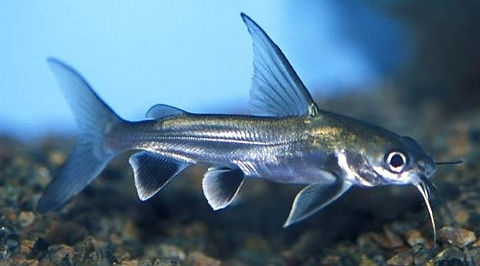

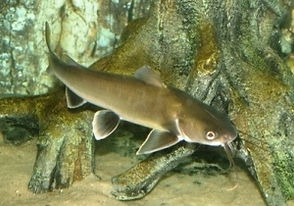
Description :
The Shark Catfish resembles an actual shark in appearance and swimming movements. It has an underslung mouth with maxillary barbels and a pair of chin barbels. The dorsal fin is located close and is pointed, and there is a venom-producing gland on the first dorsal spine. It has a rather long anal fin with 26-46 rays. These fish can grow to 13.8" (35 cm) in length when kept in proper brackish conditions, and have a life span up to 15 years.
As juveniles they are a silvery-grey color with white undersides and black pectoral, pelvic and anal fins. The common names incorporate some of the characteristics such as the white tips on its pectoral and anal fins as well as the black linings on its dorsal and tail fins. The adult coloration is a little duller but it is still a very striking fish.
One of the most interesting behaviors is the sounds they make, which can be quite loud. They produce audible clicking or grinding sounds by rubbing their pectoral fins against the sockets. Although the reason they make sounds is unknown, it may be used as signals between fish to keep the school together in murky waters or as an echolocation system similar to dolphins. In murky habitats, this type of audio navigation works better than sight or lateral lines. These fish become more vocal if feeling threatened, which can be confusing when other fish kept in the same aquarium are make clicking sounds.
-
Size of fish - inches: 13.8 inches (35.05 cm)
-
Lifespan: 15 years
Fish Keeping Difficulty :
The Silver-Tipped shark is moderately difficult to care for and so is not recommended for beginners. Although small juveniles, usually under 4 inches in length, are sold as freshwater fish, as this fish matures it will need more brackish conditions (higher salinity), up to full saltwater.
They are suggested for an intermediate fish keeper because of the required brackish conditions, their adult size, and the need for companions. A 75 gallon aquarium is large enough for one specimen, but without the company of their own kind, the Colombian Shark Catfish will act nervous and somewhat neurotic. A school of 3 or more of these fish is needed which will require at least a 100 gallon aquarium. These are a peaceful fish but are predatory. As they grow smaller tankmates will become food.
-
Aquarium Hardiness: Moderately Difficult - Due to their nervous nature, this fish tends to fall ill frequently even in well maintained tanks.
-
Aquarist Experience Level: Intermediate - With their large size and brackish water requirements, they are recommended for the Intermediate fish keeper.
Foods and Feeding :
In the wild Shark Catfish feed on small fish, insects, crustaceans, and carrion. They are considered to be areomnivorous but prefer meaty foods. They use their barbels to detect food sources and similar to sharks, they are sensitive to electric fields which enables them to find food hidden under the gravel.
As juveniles they will generally eat all kinds of live, fresh, and flake foods. To keep a good balance give them a high quality flake food or pellet everyday. As they grow they will eat pellets, earthworms, mussels, prawn, strips of octopus or fish, and sinking tablets.
-
Diet Type: Omnivore - Although omnivorous this fish prefers a greater protein component to its diet.
-
Flake Food: Yes - It make take some time to train them to eat flake.
-
Tablet Pellet: Yes
-
Live foods (fishes, shrimps, worms): Some of Diet - Live shrimp are a delicacy!
-
Vegetable Food: Some of Diet
-
Meaty Food: Some of Diet - Crustaceans like shrimp, and strips of squid or other fish are recommended.
-
Feeding Frequency: Several feedings per day - This fish grows quickly, requiring a large quantity of high quality foods as well as variety.
Aquarium Care :
The tank should have weekly water changes of 30% and the substrate should be vacuumed. Make sure to remove any dead and diseased fish as the Silver-Tip will feed on carcasses potentially getting sick itself.
Be cautious when performing tank maintenance or handling the fish for any reason. They don't bother you when cleaning the tank, but be careful to not bump them. This fish has a venom-producing gland on the first dorsal spine that can cause a cause a nasty, painful swelling. The sting is comparable to a bee sting which can be immersed into hot water. This will denature the venom and relieve the pain. Sometimes medical attention is required if the individual is particularly sensitive to the toxin.
-
Water Changes: Weekly - Do water changes of 30% weekly to keep these fish healthy.
Aquarium Setup :
Silver-tipped Sharks are large, active fish that need ample swimming space. They grow fast, reaching a length just shy of 14 inches in about 2 years. A minimum sized tank of 75 gallons can work for a single fish, but these are naturally nervous animals that need to be kept in a school of at least 3 individuals to thrive. A 100 gallon tank or more will be needed for a group. Signs that they are not comfortable include cowering in a corner or behind a filter.
As this is a riverine species, good oxygenation and water flow is appreciated. Highly oxygenated water can be accomplished using an undergravel filter and a strong power head. Strong currents are appreciated, sometimes they will continually swim into the current produced by the filter. They can jump, so a fitted cover with subdued lighting works best.
These are very active fish so need a lot of unobstructed swimming area. As juveniles they are pretty shy though, and will appreciate some cover. A good decor would be some driftwood or mangrove roots, which help mimic their surroundings in the wild. Most aquatic plants do not do well in brackish conditions but those that do will not be uprooted. The substrate like with most catfish should be soft and smooth to assure they do not injure their barbels.
Freshwater is "okay" for juveniles under 2-3 inches, but they are fast growers reaching their full size in about 2 years. These small fish will soon need a slightly brackish environment of no less than 1.002 sg to thrive. The amount of salt then needs to be increased as they grow. For an adult a specific gravity of 1.010 is recommended as a minimum, but a higher salinity of 1.015 sg to 1.025 is better. If all seems well with the environment but the fish demonstrate frantic swimming behavior, increasing the salinity can help.
-
Minimum Tank Size: 75 gal (284 L) - Silver-tipped Sharks are large and active and should be given ample swimming space. 75 gallons is adequate for a single fish but 100 or more gallons is recommended for a small group.
-
Suitable for Nano Tank: No
-
Substrate Type: Any - Be careful with sharp edges on the gravel as it can injure the barbels as they root around the substrate.
-
Lighting Needs: Any - They do not require caves and shelters although some cover is appreciated especially in high light environments.
-
Temperature: 71.0 to 79.0° F (21.7 to 26.1° C)
-
Range ph: 6.8-8.5
-
Hardness Range: 10 - 30 dGH
-
Brackish: Yes - Although it can survive in a freshwater tank as a juvenile it is recommended to have at least 1.002 sg. Salt must be added as the fish ages with 1.010 sg recommended for an adult.
-
Water Movement: Strong - As a migratory species they enjoy a current, sometimes they will spend hours swimming in-place in front of the outlet of a strong water filter.
-
Water Region: All - These are a demersal fish (bottom feeders) but will spend time swimming in open areas.
Social Behaviors :
The Silver-tipped Shark are generally a good community fish with fish their own size that are not territorial. In the wild they are a schooling fish so a group of at least three or more is recommended. If kept alone, they will be noticeably uncomfortable and exhibit skittish behavior such as darting about the aquarium and quickly swimming from top to bottom frequently. When settled in with other shark catfish, they will still be rather lively and often on the move, which is one of the attractions of keeping them. They are one of a few catfish that is active during daylight hours.
Don't keep them with fish that are much smaller since the shark catfish are predaceous and may eat smaller fish. A good choice for tankmates includes other larger schooling brackish water fish such as Monos, Scats, Garpikes, and even the more docile cichlids like green chromides. Aggressive fish do not make good companions, nor do killifish or livebearers, which they will simply see as food.
-
Venomous: Yes - They have a venom-producing gland on the first dorsal spine. If impaled, the toxin that will produce a painful sting and swelling, and submersing the affected area in hot water will relieve the pain. Medical attention is required in rare cases.
-
Temperament: Peaceful - Silver-tipped Sharks are highly predatory to smaller fish.
-
Compatible with:
-
Same species - conspecifics: Yes - These fish require a school of at least three fish.
-
Peaceful fish (): Safe - Best kept with other large schooling fish like scats, monos, garpikes, and non-aggressive cichlids.
-
Semi-Aggressive (): Monitor - Do not do well with aggressive fish like territorial cichlids.
-
Aggressive (): Threat
-
Large Semi-Aggressive (): Threat
-
Large Aggressive, Predatory (): Threat
-
Slow Swimmers & Eaters (): Threat - These are fast and aggressive at feeding time!
-
Shrimps, Crabs, Snails: Threat - is aggressive
-
Plants: Safe - Although they will root around in the substrate, they usually do not uproot plants or disturb rockwork.
-
Sex: Sexual differences :
Difficult to sex when young, under 8 inches (20 cm), but mature females are thicker-bodied than males and have lighter fins.
Breeding / Reproduction :
The Shark Catfish have not been successfully bred in aquariums. In the wild they are mouth-brooders with the male brooding the eggs. The issue with breeding these fish in aquariums is the difficulty replicating their natural breeding behavour. These fish will spawn in marine environments, the male carries the eggs in his mouth until incubation is complete. Once this happens, the male swims upstream to deposit the fry into freshwater where they begin their lifecycle and migrate back to the brackish water to live and the the oceans to spawn.
-
Ease of Breeding: Difficult - The issue with breeding these fish in aquariums is the difficulty replicating their natural breeding behavior. This fish is a migratory mouthbrooder that produces very few large eggs which the male will watch over.
Fish Diseases :
Silver-tipped sharks are fairly hardy fish when mature but are subject to the same diseases as other tropical fish. The best way to proactively prevent disease is to give them the proper environment and give them a well balanced diet. The closer to their natural habitat the less stress the fish will have, making them healthier and happy. A stressed fish is more likely to acquire disease.
One of the most common freshwater fish ailments is ich. Some other common diseases these fish can contract are Dactylogyrus Gill Fluke Disease, Skin Fluke, Cestoda infestation, and Metacercaria infection. High nitrate levels can also cause Silver-tipped sharks to develop infected barbels; this makes it difficult for them to navigate and eat normally. Maintain nitrate levels below 20 ppm.
Because they are a scaleless fish, catfish can be treated with pimafix or melafix but should not be treated with potassium permanganate or copper based medications. Malachite green or formalin can be used at one half to one fourth the recommended dosage. All medications should be used with caution.
Anything you add to your tank can bring disease to your tank. Not only other fish but plants, substrate, and decorations can harbor bacteria. Take great care and make sure to properly clean or quarantine anything that you add to an established tank so not to upset the balance. For information about fish diseases and illnesses, seeAquarium Fish Diseases and Treatments.
Availability
The Silver-tipped Shark or Shark Catfish is readily available and moderately priced at around $5.00 (2013)
References
-
Animal-World References: Freshwater Fish and Plants
-
Ariopsis seemanni (Gunther, 1864) Tete sea catfish, Fishbase
-
Ariopsis seemanni, IUCN Red List of Threatened Species
-
Neale Monks, Brackish Water Fishes: An Aquarist's Guide to Identification, Care & Husbandry, TFH Publications, 2006
6- Synodontis Catfish - Upside-Down Catfish - Naked Catfish :
Family: Mochicidae
The Synodontis catfishes do not have scales, scutes or or any other kind of body protection, thus they are also known as "Naked Catfish". Being some of the most vocal catfish they are also dubbed "Squeaker Catfish". Contrary to popular belief, most Synodontus catfishes do not swim upside down. But these fish were originally made famous for the first-kept member of the Synodontis genus, the Upside-Down Catfish, Synodontis nigriventis! This is not the prettiest member of the group, but it is intriguing because of its habit of swimming upside down. Note: In his book "AQUARIUM ATLAS, Volume 2", author Hans M. Baensch states that most of the Synodontis Catfish have not been bred in captivity, with the exception of the Upside-Down Catfish, S. nigriventis and possibly the Black Synodontis, S. nigrita. He states that nutrition is very important for the breeding of the Synodontis species and that some of the nutritional substances they get from their natural diet, notably snails and insect larvae, which may not be readily available as fish foods.
- Featherfin Squeaker
Featherfin Catfish, Featherfin Synodontis
The Featherfin Catfish is a pretty fish with delicate lacy fins and a polka dot patterning!
The Featherfin Synodontis is considered to be one of the 'upside-down' catfish species. Like their well-known relatives, the Upside-Down CatfishSynodontis nigriventris, the featherfin can swim upside down at will. They are called squeakers because they produce a squeaking sound as a warning to both predators and competitors during spawning time. The squeaking is accomplished by rubbing the spines of its pectoral fins into grooves on its shoulders. Other common names they are known by include Featherfin Catfish and Featherfin Synodontis. They are also referred to as the Lace Cat or Synodontis Lace Catfish, though this name is more often applied to its very similar cousin the Lace Synodontis Synodontis nigrita.
The Featherfin Squeaker is a great choice as a durable and attractive bottom scavenger. When kept singly they make a very handsome and intriguing showpiece, and are particularly active when feeding. They are also compatible with others of their own genus as long as the tank is large enough with plenty of rocks or driftwood for places of refuge. Each fish will pick a particular spot under a piece of driftwood or in a hole to call their own. When kept with others of their own species, they will often frolick and chas each other through tunnels and holes in a well decorated aquarium.
Featherfin Catfish are fairly hardy fish. A minimum aquarium size of 50 gallons is suggested. They are not difficult to keep in a well maintained environment and will get along well with other fish in a large community aquarium. Most other tank mates, both large and small, will get along fine as long as they aren't bottom dwellers feeding in the same area. Small bottoms feeders like Corydoras or Otocinclus can be at risk. Yet even more aggressive fish, like African cichlids, can make good tank mates for these attractive scavengers.
-
Kingdom: Animalia
-
Phylum: Chordata
-
Class: Actinopterygii
-
Order: Siluriformes
-
Family: Mochokidae
-
Genus: Synodontis
-
Species: eupterus
Habitat: Distribution / Background:
The Featherfin Squeaker Synodontis eupterus was described by Boulenger in 1901. They inhabit much of central Africa, including Nigeria, Chad, Sudan, Ghana, Mali, Niger, and Cameroon. They are found in the famous White Nile river system as well. Other common names they are known by include Featherfin Catfish, Featherfin Synodontis, Synodontis Lace Catfish, and Lace Cat. Due to their wide distribution they are not considered threatened and are listed as Least Concern (LC) on the IUCN Red List of endangered species.
Featherfin Catfish prefer living near muddy or rocky bottoms of rivers in their natural habitat, preying upon insect larvae and even eating algae. They prefer moderately fast flowing rivers. Like most catfish, they are primarily scavengers and will eat most available items that are edible. Featherfin Synodontis enjoy each other’s company in the wild and often live in small, fluctuating groups.
-
Scientific Name: Synodontis eupterus
-
Social Grouping: Groups - Can be kept singly or in groups.
-
IUCN Red List: LC - Least Concern

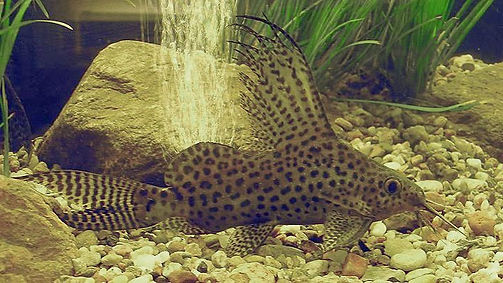

Description :
The Featherfin Squeaker is fairly large and a long-lived catfish. It can get up to 11.8 inches (30 cm) in length, though they usually only obtain 6 - 8” (15-20 cm) in the aquarium. They commonly have a lifespan of 8 to 10 years, but there are reports of them living up to 25 years.
Featherfin Catfish have a flattened underside and triangular flanks leading up to their sharp, spined dorsal fin that develops lacy extensions on the adults. The barbels are quite pronounced and very flexible allowing them to seek food and warn other competitors off with a ‘tickle’. These catfish are often spotted or patterned with varying degrees of browns and sometimes grays. Called Featherfin Synodontis, they are particularly noted for their huge, feathery fins. Because Featherfins can range greatly in color, they can easily be confused with similar Synodontis species and are often sold as a completely different species.
Juveniles and adults often look completely different and the young do not have the distinctive dorsal fin extensions. When young these fish can easily be misidentified with their close relative, the Upside-Down Catfish Synodontis nigriventris. But once the Featherfin Synodontis grows well past four inches their identity becomes clear.
Synodontis are known as squeaker catfish because they produce a squeaking sound by rubbing the spines of the pectoral fins into grooves on the shoulders. They use this sound as a warning to both predators and competitors during spawning time. Like their relatives the Upside-Down Catfish, they can also swim upside down at will. For idedntification, their distinctive characteristics are the long, flowing fins, delicately spotted body, and their eventual adult size.
-
Size of fish - inches: 11.8 inches (30.00 cm) - They usually only obtain 6-8” (15-20 cm) in the aquarium.
-
Lifespan: 25 years - Up to 25 years, but more commonly 8-10.
Fish Keeping Difficulty:
The Featherfin Squeaker perfectly fits the definition of a hardy fish. Featherfins can withstand a variety of water conditions, food types, and tank mates. They are survivors and very few of the common beginner mistakes adversely effects them. Tanks can be extremely dirty since this mimics much of their natural habitat, though a dirty tank is not recommended. One thing they do require though is a decently size aquarium, preferably over 50 gallons.
-
Aquarium Hardiness: Very Hardy
-
Aquarist Experience Level: Beginner
Foods and Feeding :
Featherfin Synodontis are omnivores that feed on insect larvae, algae, and any other foods source they can scavenge in the wild. In the aquarium they are not hard to feed at all. They are enthusiastic eaters will consume nearly any food they can locate with a rambunctious attitude. Even though they prefer to be under cover during day time, the tantalizing smell of food in the water will often bring them out of their domain for a good feasting time. Meaty foods, vegetable tablets, and anything in between will be appreciated by these hardy eaters. Brine shrimp and blood worms (either live or frozen), or even small earthworms are an excellent once a week snack.
-
Diet Type: Omnivore
-
Flake Food: Yes
-
Tablet Pellet: Yes
-
Live foods (fishes, shrimps, worms): Some of Diet
-
Vegetable Food: Some of Diet
-
Meaty Food: Some of Diet
-
Feeding Frequency: Daily
Aquarium Care :
These Synodontis are not picky about their aquarium conditions. Little maintenance has to be done to keep them in good condition. Regular siphoning of the gravel is recommended to remove waste and keep the tank in a clean state.The recommended water change is 10 - 15% every other week to keep up with the bio-load..
-
Water Changes: Bi-weekly - Bi-Weekly water changes of 10 - 15% are recommended to keep the tank from becoming heavily fouled.
Aquarium Setup :
A minimum 50 gallon aquarium is recommended for a full sized Featherfin Squeaker. This Synodontis catfish enjoys a tank with lots of hiding places, particularly driftwood. They have fun chasing each other around all the tunnels and holes, while feeling secure under the driftwood. Once they find their favorite spot, they will stay there much of their lives unless the tank is revamped or a competitor out competes them for the space. Porous rocks, such as the tufa used for African cichlid tanks, are also welcomed by these catfish. Substrate should be sand or some type of smooth gravel to reduce the chance of barbel damage. Plants also provide cover, but they must be tough and resilient since these catfish often shove away anything in their path.
-
Minimum Tank Size: 50 gal (189 L)
-
Suitable for Nano Tank: No
-
Substrate Type: Sand/Gravel Mix - Sand or smooth gravel will help reduce the chance of barbel damage.
-
Lighting Needs: Low - subdued lighting - Will appreciated overhangs and hiding places in more brightly lit aquariums.
-
Temperature: 72.0 to 81.0° F (22.2 to 27.2° C)
-
Range ph: 5.6-7.5
-
Hardness Range: 8 - 20 dGH
-
Brackish: No
-
Water Movement: Moderate
-
Water Region: Bottom
Social Behaviors:
Featherfin Catfish are not aggressive, but they aren't necessarily peaceful either. They fall into the range of semi-aggressive. They pose little risk to small fish that swim in the middle or top of the tank, but can harass smaller bottom feeders like Corydoras or Otocinclus. They also tend to be food hogs, so weak, slow eating fish will often find they have missed out at feeding time!
The Featherfin Squeaker enjoys the company of its own genus, but like the majority of Synodontis they have an intricate hierarchy system, mainly based on size. The most dominant Featherfin will get the best hiding place. The 'species internal' bullying is rarely life threatening but can cause substantial stress which may lead to illness. Watch for any individual fish getting bullied too much. Featherfins are often an excellent addition in African Cichlid tanks.
-
Venomous: No
-
Temperament: Semi-aggressive - Though basically a peaceful fish, they will harass other bottom feeders.
-
Compatible with:
-
Same species - conspecifics: Yes - They can be kept with other Synodontis if the tank is large with many hiding places.
-
Peaceful fish (): Monitor - Be cautious with smaller bottoms feeders like Corydoras or Otocinclus that compete for food.
-
Semi-Aggressive (): Safe - Can usually be kept with semi-aggressive and even aggressive fish such as Rift Lake cichlids.
-
Aggressive (): Monitor
-
Large Semi-Aggressive (): Safe
-
Large Aggressive, Predatory (): Monitor
-
Slow Swimmers & Eaters (): Monitor - Synodontis are food hogs and slow eaters may not get enough to eat.
-
Shrimps, Crabs, Snails: Threat - is aggressive - Featherfin Synodontis enjoy consuming snails.
-
Plants: Safe
-
Sex: Sexual differences
Females are usually larger than males with a bigger girth. They often develop pot bellies.
Breeding / Reproduction
Featherfin Synodontis have not been successfully bred in home aquariums, though they have been bred in fish farms with the help of added hormones.
Fish Diseases :
Synodontis euptera are very hardy fish and have no diseases they are particularly effected by. However, they are subject to the same diseases as other tropical fish. For information about freshwater fish diseases and illnesses, seeAquarium Fish Diseases and Treatments.
High nitrate levels can cause Feather-fin catfish to develop infected barbels; this makes it difficult for them to navigate and eat normally. It is recommended to maintain nitrate levels below 20 ppm.
The best way to proactively prevent disease is to give your Feather-fin Catfish the proper environment and give them a well balanced diet. The closer to their natural habitat the less stress the fish will have, making them healthier and happy. A stressed fish will is more likely to acquire disease.
Remember anything you add to your tank can bring disease to your tank. Not only other fish but plants, substrate, and decorations can harbor bacteria. Take great care and make sure to properly clean or quaranteen anything that you add to an established tank so not to upset the balance
Because they are a scaleless fish, catfish can be treated with pimafix or melafix but should not be treated with potassium permanganate or copper based medications. Malachite green or formalin can be used at one half to one fourth the recommended dosage. All medications should be used with caution.
Availability
The Featherfin Squeaker is generally available from pet stores and online and moderately priced.
References
-Animal-World References: Freshwater Fish and Plants
-Glen S. Axelrod, Brian M. Scott, Neal Pronek, Encyclopedia Of Exotic Tropical Fishes For Freshwater Aquariums, TFH Publications, 2005
-Walter Lechner, Lidia E Wysocki, Friedrich Ladich, Ontogenetic Development of Auditory Sensitivity and Sound Production in the Squeaker Catfish Synodontis schoutedeni, BMC Biology, 2010
-David Sands, African & Asian Catfishes, Tetra-Press, 1986
-Synodontis euptera Boulenger, 1901 Featherfin squeaker, Fish Base
-Synodontis eupterus, The IUCN Red List of Threatened Species
- Ocellated Synodontis :
Large-spot Catfish, Upside-Down Catfish
The Ocellated Synodontis is a catfish with plenty of spots, and sometimes very big spots!
The Ocellated SynodontisSynodontis ocellifer certainly has plenty of spots. Its scientific names originate from Greek. The genus name, a combination of "syn" meaning "together" and "odontos" meaning "tooth", describes their closely spaced mouth. The species name, however, is the telltale designation of this particular fish. The Greek word "ocellifer" means "little eyes" or "eye-like spot", which aptly describes the dark spots on its body.
This fish is also commonly known as the Large-spot Catfish. There are several color forms including black, tan, and yellow. Some have color in the finnage, while others have almost no color other than their large spots. The large spot variety is usually thought to be the most attractive of the color forms, and though it used to be quite rare it is now fairly common.
Synodontis catfishes are members of the Mochicidae family. As a group they are commonly called Naked Catfish, Upside-Down Catfish, and Squeaker Catfish, with each name reflecting a characteristic aspect of their makeup. The term "Naked Catfish" comes from the lack of scales, scutes or any other kind of body protection. They have been dubbed with the name "Squeaker Catfish" because they are some of the most vocal catfish. Contrary to popular belief, most Synodontus don't swim upside down, yet they became known as Upside-Down Catfish due to the popularity of the first-kept member of the genus, Synodontis nigriventis.
Although this Synodontis (like most of this genus) gets rather large in the wild, reaching up to 19" (20 cm), in the home aquarium they rarely exceed 10" (25.4 cm). It is an excellent addition to a large community aquarium of 50 gallons or more. It is a very peaceful bottom scavenger that appreciates having several hiding places. They are more reclusive during the day and will be most active and feed in the evenings.
Large-spot catfish are fairly hardy and are not difficult to keep in a well maintained environment, making them quite suitable for beginning aquarists. Provide a soft substrate along with a decor of rocks and wood that create plenty of caves and crevices for hiding and places of retreat. They will also appreciate some surface floating plants to help reduce the amount of daylight in the aquarium. Other plants are fine, but not necessary.
Take great caution when transporting this fish. The spines on the pectoral fins of this fish have serrated edges. It can easily be injured while netting because these spines can get caught in netting materials. The spines can also pierce most plastic bags. Transport containers of doubled up heavy duty plastic bags can work, but hard plastic or glass containers are the safest bets.
-
Kingdom: Animalia
-
Phylum: Chordata
-
Class: Actinopterygii
-
Order: Siluriformes
-
Family: Mochokidae
-
Genus: Synodontis
-
Species: ocellifer
Habitat: Distribution / Background:
The Ocellated Synodontis Synodontis ocellifer was described by Boulenger in 1900. They are found in various West and Central African river systems, and occur in river basins of the Chad, Senegal, Gambia, Volta, Niger, and the Benue. They are listed on the UCN Red List of Endangered species as Least Concern (LC) because this species has a wide distribution with no major, widespread threats identified
Another common name this species is known by is Large-spot Catfish. The Synodontis catfish belong to the Mochicidae family, and consists of over 151 different species. As a group they are commonly called Naked Catfish, Upside-Down Catfish, and Squeaker Catfish. The term "Naked Catfish" comes from the lack of scales, scutes or any other kind of body protection. The name "Squeaker Catfish" comes from their ability to make a squeaking sound with their pectoral fins. They are some of the most vocal catfish and will generally "squeak" when they are frightened, angry, or are disturbed. Contrary to popular belief, most Synodontus don't swim upside down, yet they became known as Upside-Down Catfish due to the popularity of the first-kept member of the genus, Synodontis nigriventis.
The Ocellated Synodontis inhabit slow moving streams and backwaters. These are a peaceful fish that will be found in schools as juveniles, but as adults they prefer a solitary life. They are very quiet and still during the daytime, then become active in the evening hours and at night, scavenging for food items.
They mostly eat plant matter and algae, but will also consume dead fish, worms, and other proteins. Foods they have been reported to consume in the wild include zoobenthos, mollusks, bivalves, oysters, terrestrial insects, detritus, debris, benthic algae/weeds, benthic crustaceans, zooplankton, and other planktonic invertebrates.
-
Scientific Name: Synodontis ocellifer
-
Social Grouping: Solitary - They will school when young, but are solitary as adults.
-
IUCN Red List: LC - Least Concern

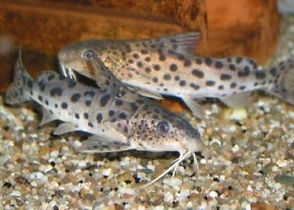
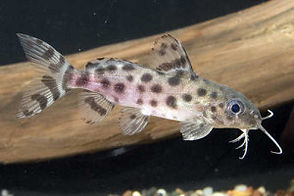
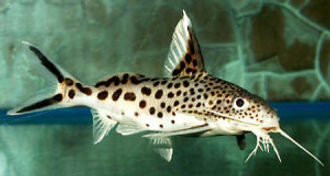
Description :
The Synodontis ocellifer have a cylindrical body with a flattened belly and a large head with small eyes. As with all in its genus, the Large-spot catfish have an armor-like hardened head cap that is attached to the humeral process behind the gill opening pointed towards the posterior. The mouth of this fish is S-shaped with a movable lower jaw and cone-shaped teeth in their upper jaw. Very important to this fish are its maxillary barbels used to navigate and locate food. There are also two pairs of mandibular barbels and nodes attached.
The dorsal and pectoral fins have hard serrated spines. They can actually use their pectoral spines to produce audible sounds when disturbed by rubbing them against their pectoral girdle. The caudal fin is forked.
It has a yellowish-brown body with black spots all over its body. There are several color forms including black, tan, and yellow. Some specimens have lighter background coloration or minimal spotting. Some have color in the finnage, while others have almost no color other than their large spots.
This species can be confused with other similar looking species of Synodontis. The characteristic to look for when comparing with other similar spotted species is the adipose fin (small fin located between the dorsal and caudal fin). In this species the adipose fin is very long, extending from just past the base of the tail to just before the caudal fin.
-
Size of fish - inches: 19.3 inches (49.00 cm) - They will generally not exceed 10 inches in the home aquarium, though fish reaching lengths of 19 inches have been reported in the wild.
-
Lifespan: 20 years
Fish Keeping Difficulty :
The Ocellated Synodontis is not a difficult fish to care for and will be great for a beginner fish keeper. However it does need a good sized tank of 50 gallons or more, and as juveniles are much more pH sensitive then adults, adult fish are the best choice for beginners. It has the characteristic sharp spines on its dorsal fin and so should be transported using a glass or plastic container rather than a net.
They require clean water that is high in oxygen and a good supply of food on the bottom of the tank. An undergravel filter system will work best, it will maintain clean water and ensure the entire tank is highly oxygenated. A little salt can be added to their water to aid in disease prevention.
These fish do a great job keeping the bottom cleaned of food and debris, making them little living vacuums. However, these fish are known to die from overeating so take care not to over feed. It can sometimes be difficult to make sure this fish is getting the proper nutrients, make sure to vary their diet.
-
Aquarium Hardiness: Moderately hardy - This fish is hardy if the tank is well kept.
-
Aquarist Experience Level: Beginner
Foods and Feeding :
The Ocellated Synodontis are omnivores and are most unfussy in terms of feeding. In the wild they will feed on just about everything. In the aquarium they will generally eat all kinds of live, frozen, and prepared foods. To keep a good balance give them high quality sinking pellets everyday, along with freeze-dried bloodworms and tubifex, and a good quality flake food. Also feed brine shrimp (either live or frozen) or blood worms as a regular treat. Make sure to provide foods with vegetables for balanced nutrition. If the tank is not established adding algae wafers to the tank is a good substitute. They will also relishes vegetable foods such as shelled peas and cucumbers.
-
Diet Type: Omnivore - Although omnivorous this fish prefers a greater protein component to its diet. Frequently treating with live foods such as bloodworms or brine shrimp is highly advised.
-
Flake Food: Yes
-
Tablet Pellet: Yes
-
Live foods (fishes, shrimps, worms): Some of Diet
-
Vegetable Food: Some of Diet
-
Meaty Food: Some of Diet
-
Feeding Frequency: Several feedings per day
Aquarium Care :
These fish need a lot of oxygen and weekly water changes are important to keep this fish happy. Water changes of 30% weekly are necessary. They do best with an undergravel filter system as it will help keep the water highly oxygenated. If there is not enough oxygen, these fish will swim to the surface and gulp air and then swim back down. If this is a common occurrence, it is a good indicator that the water quality is deteriorating.
-
Water Changes: Weekly - Do water changes of 30% weekly to keep these fish healthy.
Aquarium Setup:
The Ocellated Synodontis are good sized fish, so need a minimum sized tank of 50 gallons, with 75 gallons or more being better. Provide a setup with many hiding places as they will spend much of their time hidden under driftwood or in caves during the day. Driftwood, Large twisted roots, and rocks forming caves make great places for retreat. This will also help shelter their fry if you get lucky and they decide to breed. Driftwood is very necessary to these fish, it not only acts as a hiding place but it will also be chewed on it and they get some nutrition out of it.
Floating vegetation on the surface will help reduce the amount of light, which will also be appreciated. Other plants can be included but are not essential. Use a smooth substrate with an undergravel filter to ensure the water stays properly aerated. The use of a powerheads will aid in keeping the tank aerated. To get the most enjoyment out of this keeping this fish you can use Moonlight LEDs for nighttime viewing.
-
Minimum Tank Size: 50 gal (189 L) - A minimum sized tank of at least 50 gallons is needed, 75 gallons or more is better..
-
Suitable for Nano Tank: No
-
Substrate Type: Any - As bottom scavengers, a smooth substrate is best.
-
Lighting Needs: Moderate - normal lighting - They do prefer a dim tank during the day, floating plants on the surface to help to subdue the light. Moonlight LEDs can be added for nighttime viewing.
-
Temperature: 73.0 to 82.0° F (22.8 to 27.8° C)
-
Range ph: 6.2-7.5
-
Hardness Range: 2 - 15 dGH
-
Brackish: No
-
Water Movement: Moderate
-
Water Region: Bottom
Social Behaviors :
The Synodontis Ocellifer are peaceful bottom scavengers. They are generally a good community fish and can be kept with most tankmates, with the exception of fish that are so small they could be considered food. However they are not recommended for the general community due to their adult size. Ideal tankmates include Alestiid tetras, robust cichlids (particularly West African species), Mormyrids, Knifefish, Gouramis and larger rasboras and barbs.
This fish tends to become slightly territorial as it matures, especially towards other Synodontis catfish. However any aggression is usually far less pronounced than in some other members of the genus. It can be kept singly or maintained in a small group in a suitably sized aquarium, provided each fish is given a refuge to call home.
-
Venomous: No
-
Temperament: Peaceful
-
Compatible with:
-
Same species - conspecifics: Yes - Yes - More than one can be kept successfully in the same aquarium as long as it is large enough and each fish has its own place of refuge. They can be kept as single specimens as well.
-
Peaceful fish (): Safe
-
Semi-Aggressive (): Safe
-
Aggressive (): Monitor - Many semi-aggressive and aggressive fish will not bother the nocturnal Synodontis catfish.
-
Large Semi-Aggressive (): Monitor
-
Large Aggressive, Predatory (): Monitor
-
Slow Swimmers & Eaters (): Safe
-
Shrimps, Crabs, Snails: Safe - not aggressive
-
Plants: Safe
-
Sex: Sexual differences :
Sexing these fish is not an easy task. Normally the females are much plumper then the males. To be certain the genital papilae can be examined. Hold the fish with the dorsal fin in between your fingers making sure not the puncture your skin. Turn the fish over and carefully pull the caudal fin to expose the genital area. Males will have pointed ridged papillae and the sperm duct can be seen on the caudal side. Females papillae is round with oviduct on the opposite side then the males.
Breeding / Reproduction:
The Synodontis Ocellifer has not been bred in captivity under normal conditions, nor in the aquarium. In the wild this species are egg scatterers and exhibit no parental care. They breed where there is seasonal flooding that provides a rich assortment of micro-organisms.
With the exception of the Upside-Down Catfish, Synodontis nigriventis and possibly the Black Synodontis, Synodontis nigrita, most of the catfish in this genus have not been bred in captivity. Nutrition is very important for their breeding and some of the nutritional substances they get from their natural diet, notably snails and insect larvae, are not always readily available as fish foods.
Commercial fish farms in Europe have successful bred these fish with the use of hormone injections. Many of the young fish available in there market have been produced in this way. A number of hybrids of this species have reportedly also been appearing there in recent years. For information on the breeding of catfish in the aquarium, see: Breeding Freshwater Fish: Catfish.
-
Ease of Breeding: Unknown - Breeding has been accomplished by the use of hormone injections in Europe.
Fish Diseases :
The Synodontis Ocellifer are hardy and disease is not usually a problem in a well maintained aquarium. There is no guarantee that you won't have to deal with health problems or disease, but catfish are very resilient. The most common problem that happens to this fish are injuries from netting and transportation. Take great caution when catching and removing this fish. High nitrate levels can also cause these catfish to develop infected barbels; this makes it difficult for them to navigate and eat normally. Maintain nitrate levels below 20 ppm through regular water changes.
Because they are a scaleless fish, catfish can be treated with pimafix or melafix but should not be treated with potassium permanganate or copper based medications. Malachite green or formalin can be used at one half to one fourth the recommended dosage. Take care when treating disease as the Synodontis Ocellifer is extremely sensitive to medications.
The best way to proactively prevent disease is to give your fish the proper environment and give them a well balanced diet. The closer to their natural habitat the less stress the fish will have, making them healthier and happy. A stressed fish will is more likely to acquire disease. Anything you add to your tank can bring disease to your tank. Not only other fish but plants, substrate, and decorations can harbor bacteria. Properly clean or quarantine anything that you add to an established tank so not to add new diseases to the tank. For information about fish diseases and illnesses, see Aquarium Fish Diseases and Treatments.
Availability :
The Ocellated Synodontis Synodontis ocellifer is available from time to time. The large spot variety used to be quite rare but is fairly common today.
References :
-
Animal-World References: Freshwater Fish and Plants
-
Synodontis ocellifer (Boulenger, 1900), Fishbase
-
Synodontis ocellifer, The IUCN Red List of Threatened Species
-
Joseph S. Nelson, Fishes of the World, Wiley, 2006
-
Dr. Herbert R. Axelrod, Aquarium Fishes of the World, TFH Publications, 1998
-
Richard Geis, Catfish Keeping & Breeding Them in Captivity, T.F.H Publications, Inc. 1996
-
Dr. Rüdiger Riehl and Hans A. Baensch, Aquarium Atlas Vol. 1, Publisher Hans A. Baensch, 1991
-
David Sands, African & Asian Catfishes, Tetra-Press, 1986
7- Thorny Catfish - Talking Catfish :
Family: Doradidae
Thorny Catfish have a strong first spine on their pectoral fins, which can be used as a defensive weapon. They tend to stick out these side spines a a very rigid manner, especially when stressed.
- Spotted Raphael Catfish :
Spotted Talking Catfish, White Spotted Doradid
The Spotted Raphael Catfish makes a croaking or clicking noise when you take it out of the aquarium!
The Spotted Raphael CatfishAgamyxis pectinifrons is a very pretty fish. The body is a dark brown to blackish color adorned with an irregular pattern of small spots that can range from brilliant white to pale yellow. The fins are dark too, with both spots and stripes that may run together forming crosswise bars. This striking white-on-black patterning makes it very attractive and desirable, yet no two look fish look exactly the same!
This fish is a member of the Doradidae family. Due to its spotted appearance and its ability to vocalize it's also commonly known as the Spotted Talking Catfish. It will produces sounds, "croaks" or "clicks," by rubbing its pectoral fins across grooves in the shoulder, usually heard when removing it from its tank. A few other descriptive common names it is known by include White Spotted Talking Catfish, White Spotted Doradid, White-spot Dorydid, Talking Catfish, and Thorny Catfish.
The Doradidae family as a group is known as Thorny Catfish, which is actually a very appropriate descriptive name. They are tough skinned catfish with a well-developed nuchal shield in front of the dorsal fin and bony lumps, forming thorny scutes, along the lateral line. This family is also called "talking catfish" because they can produce audible sounds by rotating their pectoral spines in their sockets. This particular Doradid catfish is also one of the "Rafael Catfish". Another well known Rafael is the Striped Raphael Catfish or Southern Striped Raphael CatfishPlatydorus armatulus, which until 2008 was mis-identified as Platydoras costatus.
The Spotted Raphael Catfish is very hardy and tolerant of most water conditions. It makes a great choice for a beginner or any other aquarist. Being nocturnal, it is a bit shy and will look for a nice comfortable hiding place during the day. Like the Raphael Catfish, it likes to burrow in the soft river bottom in the wild, so provide a corner of fine gravel or sand. They also like to wedge themselves into tight spaces, so some hiding places in the hollows of roots or driftwood are appreciated.
They will not harm plants, in fact some floating plant cover will help keep the tank dimly lit, which keeps them happy. If plants are provided, as juveniles they will spend their day in the vegetation. They will start to come out in the evening as it gets dark, to scavenge along the bottom of the tank for tasty morsels. To get the best viewing of these fish, you can add some Moonlight LED's to the tank and watch this little cleaner come to life.
The Spotted Raphael is a peaceful catfish and does well in a community aquarium. Its an excellent companion with most other medium to large fish, only very small fish may get snacked on. With its armored thorny protection it can even be kept with more aggressive tankmates. South and Central American cichlids, larger characins, Pimelodus, and Trichogaster are all good choices. It can be kept singly, but in the wild this is a gregarious species, and a group of 4 or more can be happily kept in a good sized aquarium. It will also school with similar looking catfish relatives.
Thorny Catfish have a strong first spine on their pectoral fins, which can be used as a defensive weapon. They tend to stick out these side spines out in a very rigid manner, especially when stressed. To catch them it's best to use a glass container or plastic bag as these spines can easily get caught in a net. Trying to get them untangled is not only stressful, but a bit dangerous. A prick from the spines of this fish is quite painful!
-
Kingdom: Animalia
-
Phylum: Chordata
-
Class: Actinopterygii
-
Order: Siluriformes
-
Family: Doradidae
-
Genus: Agamyxis
-
Species: pectinifrons
Habitat: Distribution / Background :
The Spotted Raphael Catfish Agamyxis pectinifrons was described by Cope in 1870. They are found in the Amazon basin, occurring in Bolivia, Brazil, Colombia, and Peru. They are not listed on the UCN Red List of Endangered species. Other common names they are known by are Spotted Talking Catfish, White Spotted Talking Catfish, White Spotted Doradid, White-spot Dorydid, Talking Catfish, and Thorny Catfish.
It is one of the "Rafael Catfish". Other Rafael's include three almost identical striped species with each originating from different localities, the Raphael catfish Platydoras costatus, the Striped Raphael Catfish or Southern Striped Raphael Catfish Platydorus armatulus (which until 2008 was mis-identified as Platydoras costatus), and the Longnose Rafael or Long Nosed Raphael Catfish Orinocodoras eigenmanni. The Long Nosed variety is differentiated by a slightly longer snout.
It belongs to the Doradidae family, which are known as Thorny Catfish. These are tough skinned catfish with a well-developed nuchal shield in front of the dorsal fin and bony lumps, forming thorny scutes, along the lateral line. This family is also called "talking catfish" because they can produce audible sounds by rotating their pectoral spines in their sockets. The Doradidae family is by no means the only types of catfish that can make vocalizations, the Squeaker Catfish of the Mochokidae family are also noted as being very vocal.
Some others Doradid's called "talking catfish" include the Spiny Catfish Acanthodoras spinosissimus. Unlike the Spotted Talking Catfish, it is not suitable for a community aquarium as it will eat smaller fish. Another is the Painted Talking Catfish Acanthodoras cataphrectus. This is a very pretty with an almost paisley type design in its patterning, and it is also a very peaceful fish that does well in a community aquarium.
Spotted Raphael Catfish are found in a variety of habitats but seem to be most comfortable in slow to still moving water with a lot of plants and roots for concealment . During the rainy season these fish will normally migrate into the flooded food rich forests. In the wild they feed on crustaceans, worms, insects, and plant matter.
They are gregarious in nature and will school with their own kind and with other similar-looking relatives like the Raphael Catfish Platydoras armatulus, Spiny Catfish Acanthodoras spinosissimus, and Blue-eye catfish or Longnose Dora Platydoras hancockii.
-
Scientific Name: Agamyxis pectinifrons
-
Social Grouping: Groups - They are gregarious in nature and will school with their own kind and with other similar-looking relatives.
-
IUCN Red List: NE - Not Evaluated or not listed
Description :
The Spotted Raphael Catfish have a cylindrical, arrow-shaped body with a flattened belly. Females are more full bodied than males. They can reach up to 5.9 inches (15 cm) in length, and have a lifespan of about 10 years.
These catfish have a large head with small eyes. The mouth is large and there are three pairs of barbels, one on the upper jaw and two on the lower. As with all in its genus, they are tough skinned catfish with a well-developed nuchal shield in front of the dorsal fin. Bony bony lumps form thorny scutes along the lateral line.
The dorsal fin stands erect and they have a strong first spine on their pectoral fins. They are called "talking catfish" because they have the ability to produce audible sounds by rubbing their pectoral fins across grooves in the shoulder. This sound is amplified by the swim bladder. Croaks or clicks will often be heard when removing them from their tank.
The pectoral spines can be extended out to the side in a very rigid manner and be used as a defensive weapon. These spines can easily become entangled in a net. Untangling them is stressful to the fish and a bit dangerous for the keeper, as a prick from these spines can be quite painful.
The body color is a dark brown to bluish-black with an irregular pattern of small spots that can range from brilliant white to pale yellow. The fins are dark too, with both spots and stripes that may run together forming crosswise bars. Their bellies are normally lighter in color with similar spots. As these catfish age they become more of a solid darker color with a white underside. No two look fish look exactly the alike.
A species that's very similar in appearance is its close relative, the Spiny catfish Agamyxis albomaculatus. In fact these two are so similar in looks that to distinguish them, you need to know where they are collected. The Spotted Raphael is from the Amazon Basin in Bolivia, Brazil, Colombia and Peru, while the Spiny Catfish has a very restricted occurrence, known only from the Río Orinoco drainage in Venezuela.
-
Size of fish - inches: 5.9 inches (15.01 cm)
-
Lifespan: 10 years - They have an average lifespan of 10 years.
Fish Keeping Difficulty :
The Spotted Raphael Catfish is fairly hardy, making it a great choice for a beginning fish keeper. They are fairly small and and not very picky about what they eat. These are bottom scavengers that do a great job cleaning the tank.
Their water requirements are very easy to meet and their temperament is of a peaceful nature, making them good community fish. There is not usually much of a need to upgrade to a bigger tank as much as it is with some of the larger catfish, unless you want to increase the number of fish you're keeping. They do have sharp spines on the dorsal fins and so should be transported using a glass or plastic container rather than a net.
-
Aquarium Hardiness: Moderately hardy
-
Aquarist Experience Level: Beginner - This is a great first catfish.
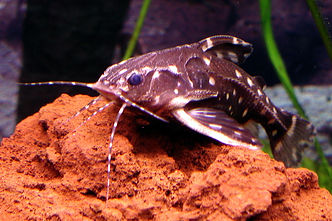
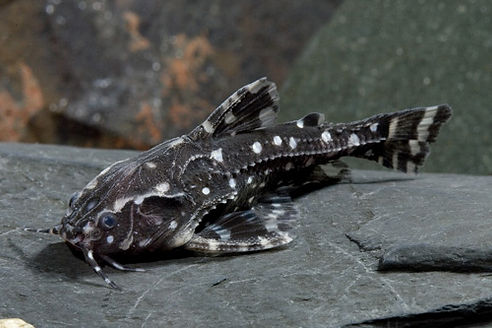
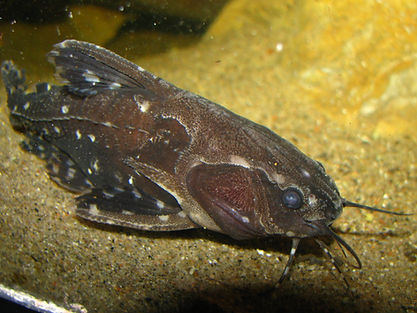
Foods and Feeding :
The Spotted Raphael Catfish are omnivores and not fussy terms of feeding. In the wild they will feed on a variety of crustaceans, worms, insects, and plant matter. They are bottom feeders, and In the aquarium they will eat any food that reaches them. Feed them daily, being nocturnal they prefer to be fed right before or after the lights are turned off on the aquarium.
To keep a good balance give them high quality sinking pellets everyday, along with freeze-dried bloodworms and tubifex. They will also eat all kinds of live, frozen, and prepared foods, including flakes, that have sunk to the bottom. Protein foods are important for them, so the occasional whole or chopped earthworm is good as a regular treat. They will eat snails, so can be employed to clean up a snail overpopulation, as long as the aquarium's conditions are suitable for this fish.
-
Diet Type: Omnivore - They do eat some plant matter in the wild, but protein is the main staple of their diet.
-
Flake Food: Yes - They will eat any foods that reach the bottom of the aquarium.
-
Tablet Pellet: Yes
-
Live foods (fishes, shrimps, worms): Some of Diet
-
Vegetable Food: Some of Diet
-
Meaty Food: Most of Diet
-
Feeding Frequency: Daily - This fish is nocturnal and prefers to be fed right before or after lights out in the aquarium.
Aquarium Care :
These are hardy fish that tolerate most water conditions. In the wild the shallow flood waters of its homeland can cool off drastically at night, and they then tolerate temperatures as low as to 15° C for a short period. But extremes should be avoided in the aquarium to avoid stress and illness.
They are very low maintenance and their tank only requires water changes of 30% a month. There really isn't much that needs to be done for the easy going catfish. This is one of the catfish that have sharp spines not only on the dorsal fins but on the pectoral fin as well. It is better to capture them in a glass or plastic container for transport.
-
Water Changes: Monthly - These low maintenance fish only require water changes of 30% a month.
Aquarium Setup :
The Spotted Raphael Catfish are moderately sized fish. They need a minimum sized tank of 35 gallons, with 45 gallons or more being better. They tend to be nocturnal, getting most active in the evening and nighttime when they come out to scavenge for food. They may seem shy during the day, spending much of their time hiding, but once they are comfortable they will come out for a swim around. As with most catfish they enjoy well oxygenated waters and this can be accomplished using an undergravel filter and a powerhead. They prefer slightly acid water with low hardness.
Provide a dimly lit setup with hiding places. Plants, twisted roots, and driftwood are the best decor. They will not harm plants and will appreciate some in floating cover as well, to help reduce the light. When young they tend to hide in dense vegetation, but they also like to wedge themselves into tight crevices and to burrow. Provide a sandy or fine gravel bottom with at least one corner without plants.
-
Minimum Tank Size: 35 gal (132 L) - A 35 gallon tank is minimum, but 45 gallons or more is better, especially for a larger community.
-
Suitable for Nano Tank: No
-
Substrate Type: Sand - Sand or fine gravel that will allow this fish to burrow.
-
Lighting Needs: Low - subdued lighting
-
Temperature: 68.0 to 79.0° F (20.0 to 26.1° C)
-
Range ph: 5.8-7.5
-
Hardness Range: 2 - 20 dGH
-
Brackish: No
-
Water Movement: Weak
-
Water Region: Bottom
Social Behaviors :
The Spotted Raphael Catfish are peaceful bottom scavengers. They are a good community fish and are friendly with other medium to large community tank mates, avoid fish that are so small they could be considered food. They can be kept singly, but they have a gregarious nature and enjoy being in groups of 4 or more. They will also school with similar looking catfish relatives. With its armored thorny protection it usually be kept with more aggressive tankmates. South and Central American cichlids, larger characins, Pimelodus, and Trichogaster are all good choices.
-
Venomous: No - Although not venomous, the Spotted Raphael Catfish is armed with a set of spines sharp enough to do damage to the aquarists hand.
-
Temperament: Peaceful
-
Compatible with:
-
Same species - conspecifics: Yes - This fish is gregarious and enjoys the company of its own kind, keeping 4 or more is recommended.
-
Peaceful fish (): Safe
-
Semi-Aggressive (): Safe
-
Aggressive (): Monitor
-
Large Semi-Aggressive (): Monitor - Can usually be kept with semi-aggressive and even aggressive fish such as cichlids.
-
Large Aggressive, Predatory (): Monitor
-
Slow Swimmers & Eaters (): Safe
-
Shrimps, Crabs, Snails: Threat - is aggressive - The Raphael Catfish are sometimes used to rid an aquarium of snails.
-
Plants: Safe
-
Sex: Sexual differences :
Mature females tend to be noticeably plumper then the males.
Breeding / Reproduction:
The Spotted Raphael Catfish has rarely been bred in captivity other than artificially with the use of hormones. Some spawning success has said to have happened, but reported as being accidental and there is little information is available.
It is believed that they may be a bubble nest builders in nature, with eggs laid among floating plants. It has been reported that other species of small Doradidae could be called nest builders. In the tank they may gather up general debris or find an area with old leaf litter and tidbits of wood, and try to hide beneath it. Then other fish of the same species will tend to swim around this "nest." But whether they had a successful spawn has not been reported. For information on the breeding of catfish in the aquarium, see: Breeding Freshwater Fish: Catfish.
-
Ease of Breeding: Unknown
Fish Diseases :
The Spotted Raphael Catfish are fairly hardy when mature, but are subject to the same diseases as other tropical fish. Disease is not usually a problem in a well maintained aquarium and these catfish are very resilient. The most common problem that happens to this fish are injuries from netting and transportation. Take great caution when catching and removing this fish. High nitrate levels can also cause these catfish to develop infected barbels; this makes it difficult for them to navigate and eat normally. Maintain nitrate levels below 20 ppm through regular water changes.
Because they are a scaleless fish, catfish can be treated with pimafix or melafix but should not be treated with potassium permanganate or copper based medications. Malachite green or formalin can be used at one half to one fourth the recommended dosage. Take care when treating disease as the Synodontis Ocellifer is extremely sensitive to medications.
The best way to proactively prevent disease is to give your fish the proper environment and give them a well balanced diet. The closer to their natural habitat the less stress the fish will have, making them healthier and happy. A stressed fish will is more likely to acquire disease. Anything you add to your tank can bring disease to your tank. Not only other fish but plants, substrate, and decorations can harbor bacteria. Properly clean or quarantine anything that you add to an established tank so not to add new diseases to the tank. For information about fish diseases and illnesses, see Aquarium Fish Diseases and Treatments.
Availability :
The Spotted Raphael Catfish, also commonly called the Spotted Talking Catfish, is readily available at pet stores and online, and is reasonable in price.
References
-
Animal-World References: Freshwater Fish and Plants
-
Agamyxis pectinifrons (Cope, 1870) Whitebarred catfish, Fishbase
-
Joseph S. Nelson, Fishes of the World, Wiley, 2006
-
Lee Finley, Catfishes: The Complete Guide to the Successful Care and Breeding of More Than 100 Catfish Species, T.F.H Publications, Inc. 2003
-
Dr. Herbert R. Axelrod, Aquarium Fishes of the World, TFH Publications, 1998
-
Dr. Rüdiger Riehl and Hans A. Baensch, Aquarium Atlas Vol. 1, Publisher Hans A. Baensch, 1991
- Striped Raphael Catfish :
Humbug catfish, Chocolate Catfish, Striped Talking Catfish
The Striped Raphael Catfish is very peaceful and thought to be the nicest of the Thorny Catfish!
The Striped Raphael CatfishPlatydoras armatulus has been a favorite of aquarium enthusiasts for a very long time. These are very pretty catfish with broad black and white stripes that run the length of their body. The pattern is especially striking when young, though as they mature the striping is not quite as strong. They also get pretty big as in the wild, generally growing to about 7.9 inches (20 cm) in length, yet in the aquarium they are usually closer to about 6 inches (15.25 cm).
These are really fun fish to watch as they have a curious nature. They are nocturnal, but once they are comfortable in their environment they will often spend many daytime hours exploring the aquarium. They are very peaceful and hardy. An excellent choice for the beginning aquarist, or any catfish enthusiasts that wants to keep a moderately large community tank.
This fish is a member of the Doradidae family, commonly known as Thorny Catfish. This is actually very appropriate as they are tough skinned catfish with a well-developed nuchal shield in front of the dorsal fin and bony lumps running along the lateral line that form thorny scutes. A curious fact about the Striped Raphael Catfish is that these bony lumps become tiny curved spines that offer great protection. This group is also called "talking catfish due to their ability to vocalize. They produces sounds, croaks, clicks, or squeaks, by rubbing their pectoral fins across grooves in the shoulder, which is amplified by the swim bladder. Thus this fish is commonly called the Striped Talking Catfish. Other common names it is known by are Humbug Catfish, Chocolate Catfish, Striped Dora, and Southern Striped Raphael Catfish.
The Striped Raphael Catfish are very hardy and tolerant of most water conditions. Although they are naturally nocturnal, they have a typical feline curiosity, and once comfortable in their home they will often venture out to explore during the day. They like to burrow in the soft river bottom so be sure to provide a corner of fine gravel or sand. They also like some plant cover to help keep their tank dimly lit and hiding places like the hollows of roots or driftwood, clay flowerpots, or pieces of plastic piping. Plant are appreciated but not essential.
These are very peaceful and a great catfish choice for a beginning aquarist. They do well in a community aquarium and make an excellent companion with most other medium to large fish, only very small fish may get snacked on. With its armored thorny protection it can even be kept with more aggressive tankmates.
-
Kingdom: Animalia
-
Phylum: Chordata
-
Class: Actinopterygii
-
Order: Siluriformes
-
Family: Doradidae
-
Genus: Platydoras
-
Species: armatulus
Habitat: Distribution / Background :
The Striped Raphael Catfish Platydoras armatulus was described by Valenciennes in 1840. They are found widespread distribution across South America. They occur in the Amazon basin in Peru, Bolivia and Brazil as well as a couple other river basins in Brazil; in the Rio Orinoco basin in Colombia and Venezuela; in the Rio Essequibo in Guyana; and in coastal drainages of Suriname and French Guiana. They are not listed on the UCN Red List of Endangered species. Other common names they are known by are Humbug catfish, Chocolate Catfish, Striped Talking Catfish, Striped Dora, and Southern Striped Raphael Catfish.
For many years, until sorted out by Piorski et al in late 2008, the Striped Raphael Catfish was ms-identified asPlatydoras costatus. But that species is the Rafael Catfish and it is not the commonly available species as it has a very limited distribution, found only in two rivers in eastern South America. The Striped Raphael Catfish on the other hand, has a very wide distribution across South America. It is found in both the Amazon and Orinoco basins and it is the species that has been collected for the hobby for decades.
It belongs to the Doradidae family, which are known as Thorny Catfish. These are tough skinned catfish with a well-developed nuchal shield in front of the dorsal fin and bony lumps, forming thorny scutes, along the lateral line. This family is also called "talking catfish" because they can produce audible sounds by rotating their pectoral spines in their sockets. The Doradidae family is by no means the only types of catfish that can make vocalizations, the Squeaker Catfish of the Mochokidae family are also noted as being very vocal.
Some others Doradid's called "talking catfish" include the Spiny Catfish Acanthodoras spinosissimus. Unlike the Spotted Talking Catfish, it is not suitable for a community aquarium as it will eat smaller fish. Another is the Painted Talking Catfish Acanthodoras cataphrectus. This is a very pretty with an almost paisley type design in its patterning, and it is also a very peaceful fish that does well in a community aquarium.
The Striped Raphael Catfish inhabit the slow moving or standing waters of tributaries, creeks and swamps that provide shelter among roots or submerged vegetation. They feed on mollusks, crustaceans, and organic debris. They are normally found in soft sandy areas that also allow them to retreat under the substrate for protection. During the rainy season these fish will move to the food rich flooded forests. They are somewhat territorial, but will school for protection in the wild.
It has been recorded that juveniles are known to clean piscivorous fish (those that feed on other fish) like the Wolf Fish or Tiger Fish Hoplias cf. malabaricus, removing parasites and dead scales. As juveniles they are similar to other types of cleaner fish, having a strong striped patterning. This pattern is thought to possibly be a signal that is recognized as indicating a cleaning service rather than as a food item. The striping fades as the fish mature, so it has been suggested that may be why the cleaning behavior has only been recorded with juveniles.
-
Scientific Name: Platydoras armatulus
-
Social Grouping: Groups - Thought somewhat territorial, they will school for protection in the wild.
-
IUCN Red List: NE - Not Evaluated or not listed
Description :
The Striped Raphael Catfish have a cylindrical, arrow-shaped body with a flattened belly. Females are more full bodied than males when seen from above. They will generally reach up to 7.9 inches (20 cm) in length in the wild, with an occasional specimen reportedly reaching up to 9 1/2 inches (24 cm). In the aquarium they will usually grow to about 6 inches. They have an average lifespan of up to about 20 years, and one specimen is said to have reached 22 years in captivity.
The body color is a dark brown to black with conspicuous white lateral bands creating a striping pattern. The snout, lower part of the head, and the front edge of the pectoral fins are also white. As these catfish age the striping pattern is not as strong.
These catfish have a big head with large eyes. The mouth is large and there are two pairs of maxillary barbels. They are on either side of the mouth, with one on the lower and one on the upper jaw. As with all in its genus, they are tough skinned catfish with a well-developed nuchal shield in front of the dorsal fin. Bony lumps form thorny scutes along the lateral line, which become tiny protective curved spines.
They have a strong spines on their pectoral fins that can be extended out to the side in a very rigid manner, and the inner spines can be used to sting. These spines can easily become entangled in a net. Untangling them is stressful to the fish and a bit dangerous for the keeper, as a prick from these spines can be quite painful. They are called "talking catfish" because they have the ability to produce audible sounds by rubbing their pectoral fins across grooves in the shoulder. This sound is amplified by the swim bladder and sounds like croaks, clicks, or squeaks.
The Striped Raphael is often confused and offered for sale with the Long Nosed Raphael Catfish Orinocodoras eigenmanni, due to their many similarities. They can be distinguished however, by the longer snout on the Long Nosed Raphael and its longer adipose fin. Though if you don't know the identity of your fish, it isn't a big deal as they both require the same care.
-
Size of fish - inches: 9.5 inches (24.00 cm)
-
Lifespan: 20 years - Their average lifespan is about 20 years, several are reported by hobbyists at 15 years old, and one at 22 years.
Fish Keeping Difficulty :
The Striped Raphael Catfish is hardy and moderate in size, making it a great first catfish for the beginning aquarist. They do a great job cleaning the tank and not very picky about what they eat. These are bottom scavengers that do a great job cleaning the tank. Their water requirements are very easy to meet and their temperament is of a peaceful nature, making them good community fish. There is not usually much of a need to upgrade to a bigger tank as much as it is with some of the larger catfish, unless you want to increase the number of fish you're keeping.
Thorny Catfish have a strong first spine on their pectoral fins, which can be used as a defensive weapon. They tend to stick out these side spines out in a very rigid manner, especially when stressed. It is best to catch the Striped Raphael Catfish with a glass container or plastic bag. The spines can easily get caught in a net and it can be difficult to try and get them untangled, and it is also a bit dangerous. A prick from the spines of this fish is quite painful!
-
Aquarium Hardiness: Moderately hardy
-
Aquarist Experience Level: Beginner
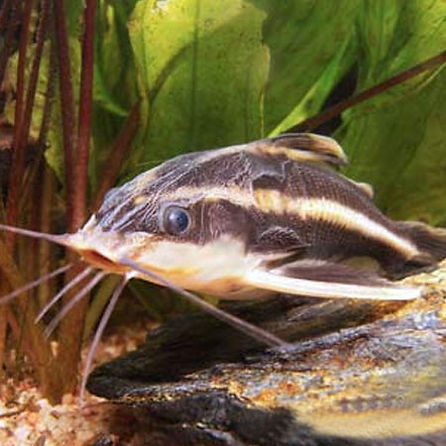
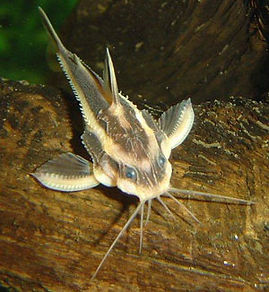
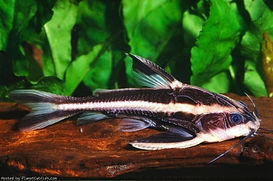
Foods and Feeding :
The Striped Raphael Catfish are omnivores and not fussy terms of feeding. In the wild they will feed on a mollusks, crustaceans, and organic debris. They are bottom feeders and In the aquarium they will eat any food that reaches them. Feed them daily, and since they are nocturnal the best time to feed these fish is after the tank light is turned off with a night light in the room. One thing to be careful of is overfeeding. It has been reported that they will actually eat themselves to death if given too much food.
Protein foods are most important for them, though they will graze on some algae. To keep a good balance give them high quality sinking pellets everyday, along with freeze-dried bloodworms and tubifex. They will eat live foods such as bloodworms, earthworms, and tubifex. They are bottom feeders and may also eat frozen foods as well as flakes that have sunk to the bottom.
-
Diet Type: Omnivore - They do eat some organic debris in the wild, but protein is the main staple of their diet.
-
Flake Food: Yes
-
Tablet Pellet: Yes
-
Live foods (fishes, shrimps, worms): Some of Diet
-
Vegetable Food: Some of Diet
-
Meaty Food: Most of Diet
-
Feeding Frequency: Daily - This fish is nocturnal and prefers to be fed right before or after lights out in the aquarium.
Aquarium Care :
These are hardy fish that tolerate most water conditions. There really isn't much that needs to be done for the easy going catfish. They are very low maintenance and their tank only requires water changes of 30% a month. This is one of the catfish that have sharp spines not only on the dorsal fins but on the pectoral fin as well. It is better to capture them in a glass or plastic container for transport.
-
Water Changes: Monthly - These low maintenance fish only require water changes of 30% a month.
Aquarium Setup :
The Striped Raphael Catfish are moderate in size but not overly active, so a 30 gallon aquarium or larger will suit them fine. Although they tend to be nocturnal, getting most active in the evening and nighttime when they come out to scavenge for food, they are also quite curious. Once they are comfortable in their home, they will often come out during the day to explore. As with most catfish they enjoy well oxygenated waters and this can be accomplished using an undergravel filter and a powerhead. They prefer slightly softer water but it is not essential.
Provide a dimly lit setup with hiding places. The hollows of roots or driftwood, clay flowerpots, or pieces of plastic piping work well as places of refuge. They also like to burrow in the soft river bottom so be sure to provide an open corner with fine gravel or sand. They will not harm plants and will appreciate some in floating cover as well, to help reduce the light. They will graze on algae though, and some of the smaller leaved plants may get a silty dusting when this catfish burrows into the sand.
In the evening as it starts to gets dark, they will come out to scavenge along the bottom of the tank for tasty morsels. If you want to observe this fish at night, try adding a red light or some Moonlight LED's to the tank and enjoy it foraging for food.
-
Minimum Tank Size: 30 gal (114 L) - A 30 gallon tank is minimum as this fish is not overly active, though more room is better when keeping it with a larger community.
-
Suitable for Nano Tank: No
-
Substrate Type: Sand - Sand or Sand/Gravel mix that the fish can burrow in.
-
Lighting Needs: Low - subdued lighting
-
Temperature: 75.0 to 86.0° F (23.9 to 30.0° C)
-
Range ph: 5.8-7.5
-
Hardness Range: 2 - 20 dGH
-
Brackish: No
-
Water Movement: Weak
-
Water Region: Bottom
Social Behaviors :
The Striped Raphael Catfish are peaceful bottom scavengers. They are a good community fish and are very friendly with other medium to large fish. They have the reputation of being the nicest of the Thorny Catfish species and get along well with most other tankmates, but avoid fish that are so small they could be considered food. With its armored thorny protection it can usually be kept with more aggressive tankmates too. South and Central American cichlids, larger tetras and other characins, cyprinids, gouramis and other anabantoids, livebearers, and other non-territorial catfish all make good companions.
They can be kept singly or in a group. When kept with their own kind they are somewhat territorial, so there may be some scuffling, but no damage is caused and they will then often share the same hideout. In the wild they will school together at times for protection.
-
Venomous: No - Although not venomous, the Striped Raphael Catfish is armed with a set of spines sharp enough to do damage to the aquarists hand.
-
Temperament: Peaceful
-
Compatible with:
-
Same species - conspecifics: Yes - They are somewhat territorial and may tussle on occasion when kept in a group, but no damage is done.
-
Peaceful fish (): Safe - The Striped Raphael will eat fish small enough to fit in its mouth.
-
Semi-Aggressive (): Monitor - Can usually be kept with semi-aggressive and aggressive fish such as cichlids.
-
Aggressive (): Monitor
-
Large Semi-Aggressive (): Monitor
-
Large Aggressive, Predatory (): Monitor
-
Slow Swimmers & Eaters (): Safe
-
Shrimps, Crabs, Snails: Threat - is aggressive - In the wild, this fish hunts at night for mollusks and crustaceans.
-
Plants: Safe
-
Sex: Sexual differences
Mature females tend to be plumper then males when seen from above.
Breeding / Reproduction
The Striped Raphael Catfish has rarely been bred in captivity. These are spawning fish that so far are only bred commercial using hormone injections. Some spawning success has happened in the aquarium, as fry have been found, but it is accidental. A few successful breedings have also been reported in very large tanks however this is not easily accomplished and there is little information is available.
In the wild this spawning species releases its eggs into the rivers and streams to be fertilized. It has been reported that other species of small Doradidae could be called nest builders. In the tank they may gather up general debris or find an area with old leaf litter and tidbits of wood, and try to hide beneath it. Then other fish of the same species will tend to swim around this "nest." But whether they had a successful spawn has not been reported. For information on the breeding of catfish in the aquarium, see: Breeding Freshwater Fish: Catfish.
-
Ease of Breeding: Unknown
Fish Diseases :
The Striped Raphael Catfish are fairly hardy but are subject to the same diseases as other tropical fish. Disease is not usually a problem in a well maintained aquarium and these catfish are very resilient. The most common problem that happens to this fish are injuries from netting and transportation. Take great caution when catching and removing this fish. High nitrate levels can also cause these catfish to develop infected barbels; this makes it difficult for them to navigate and eat normally. Maintain nitrate levels below 20 ppm through regular water changes.
Because they are a scaleless fish, catfish can be treated with pimafix or melafix but should not be treated with potassium permanganate or copper based medications. Malachite green or formalin can be used at one half to one fourth the recommended dosage. Take care when treating disease as the Synodontis Ocellifer is extremely sensitive to medications.
The best way to proactively prevent disease is to give your fish the proper environment and give them a well balanced diet. The closer to their natural habitat the less stress the fish will have, making them healthier and happy. A stressed fish will is more likely to acquire disease. Anything you add to your tank can bring disease to your tank. Not only other fish but plants, substrate, and decorations can harbor bacteria. Properly clean or quarantine anything that you add to an established tank so not to add new diseases to the tank. For information about fish diseases and illnesses, see Aquarium Fish Diseases and Treatments.
Availability :
The Spotted Raphael Catfish is readily available at pet stores and online, and is reasonable in price. It may also be called the also called the Humbug catfish, Chocolate Catfish, Striped Talking Catfish, or Striped Dora.
References
-
Animal-World References: Freshwater Fish and Plants
-
Platydoras armatulus (Valenciennes, 1840) Southern striped raphael, Fishbase
-
Joseph S. Nelson, Fishes of the World, Wiley, 2006
-
Dr. Herbert R. Axelrod, Aquarium Fishes of the World, TFH Publications, 1998
-
Richard Geis, Catfish Keeping & Breeding Them in Captivity, T.F.H Publications, Inc. 1996
-
Dr. Rüdiger Riehl and Hans A. Baensch, Aquarium Atlas Vol. 1, Publisher Hans A. Baensch, 1991
-
Richard Geis, Catfish Keeping & Breeding Them in Captivity, T.F.H Publications, Inc. 1996
-
Nivaldo M. Piorski, Julio C. Garavello, Mariangeles Arce H. and Mark H. Sabaj Perez, Platydoras brachylecis, a new species of thorny catfish (Siluriformes: Doradidae) from northeastern Brazil, Neotropical Ichthyology, 2008
